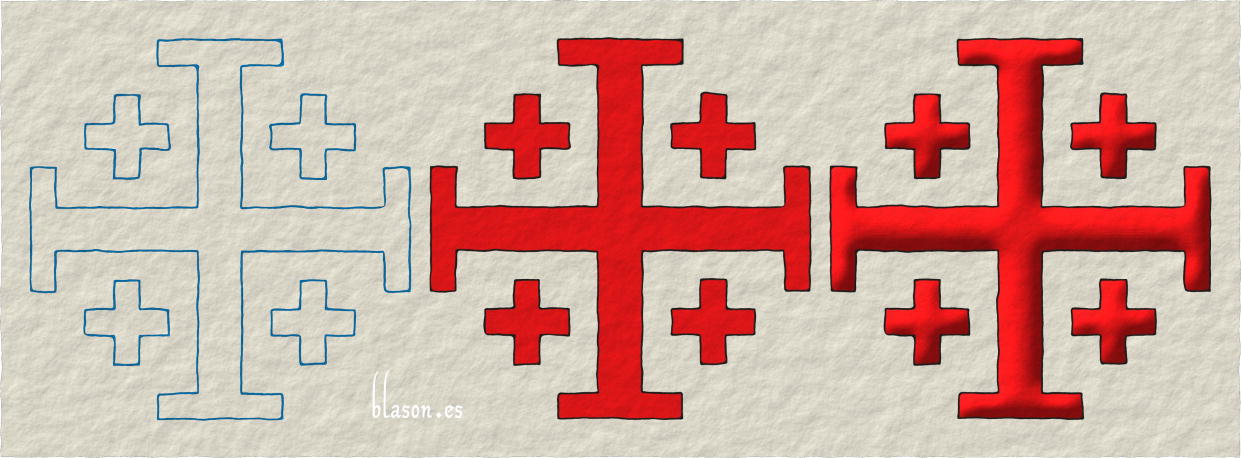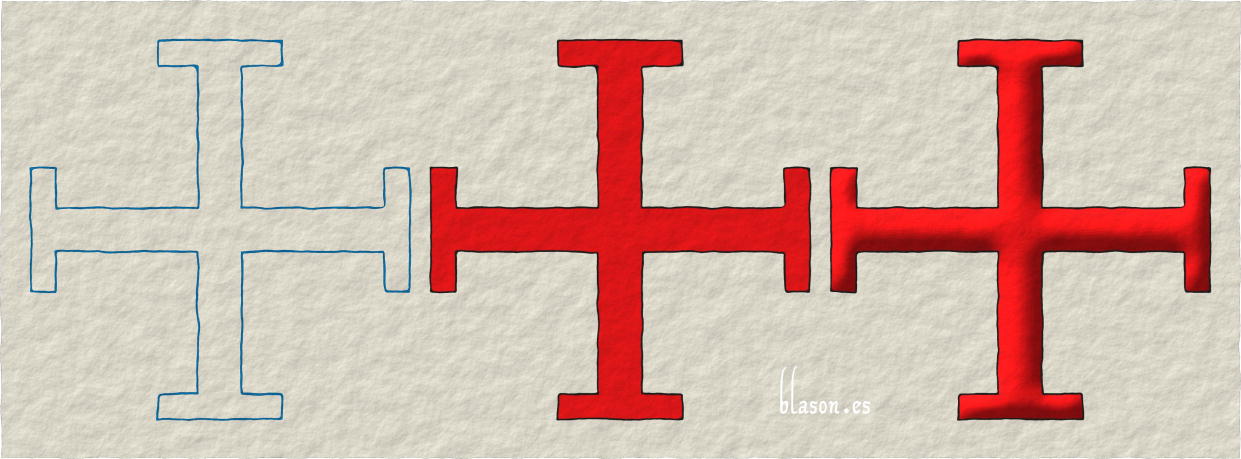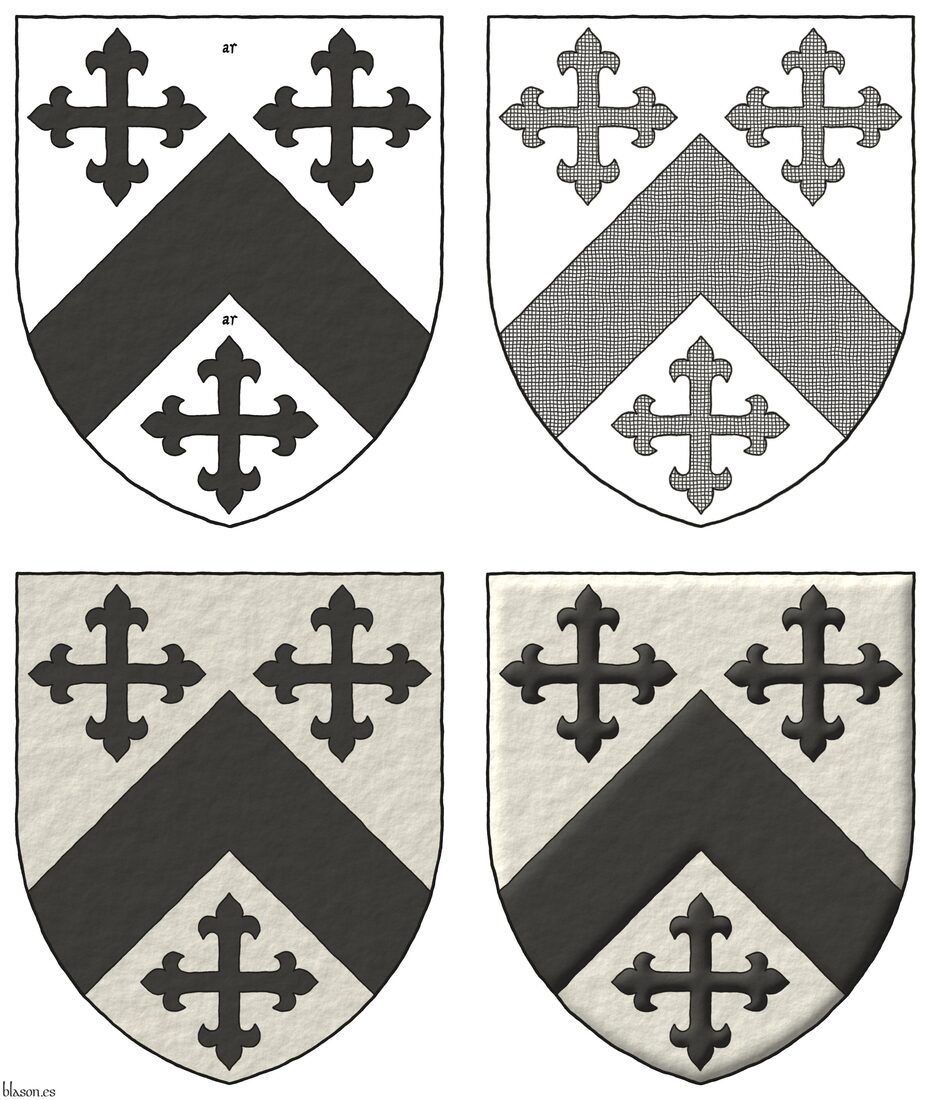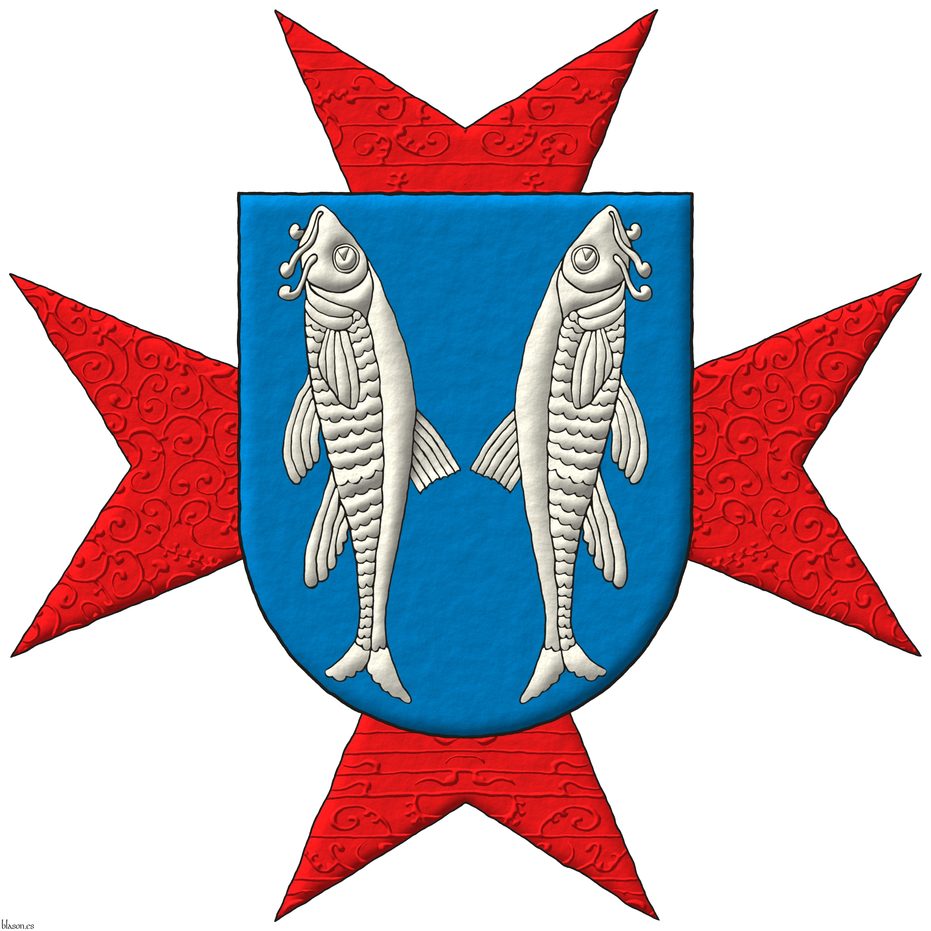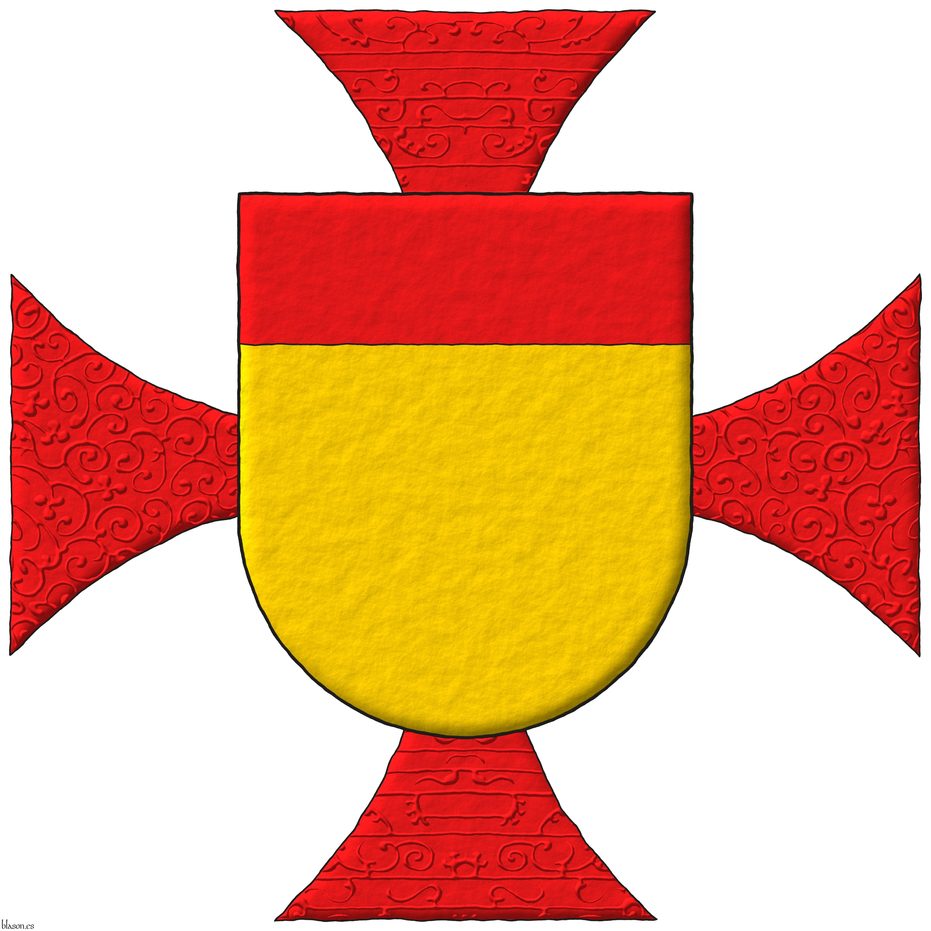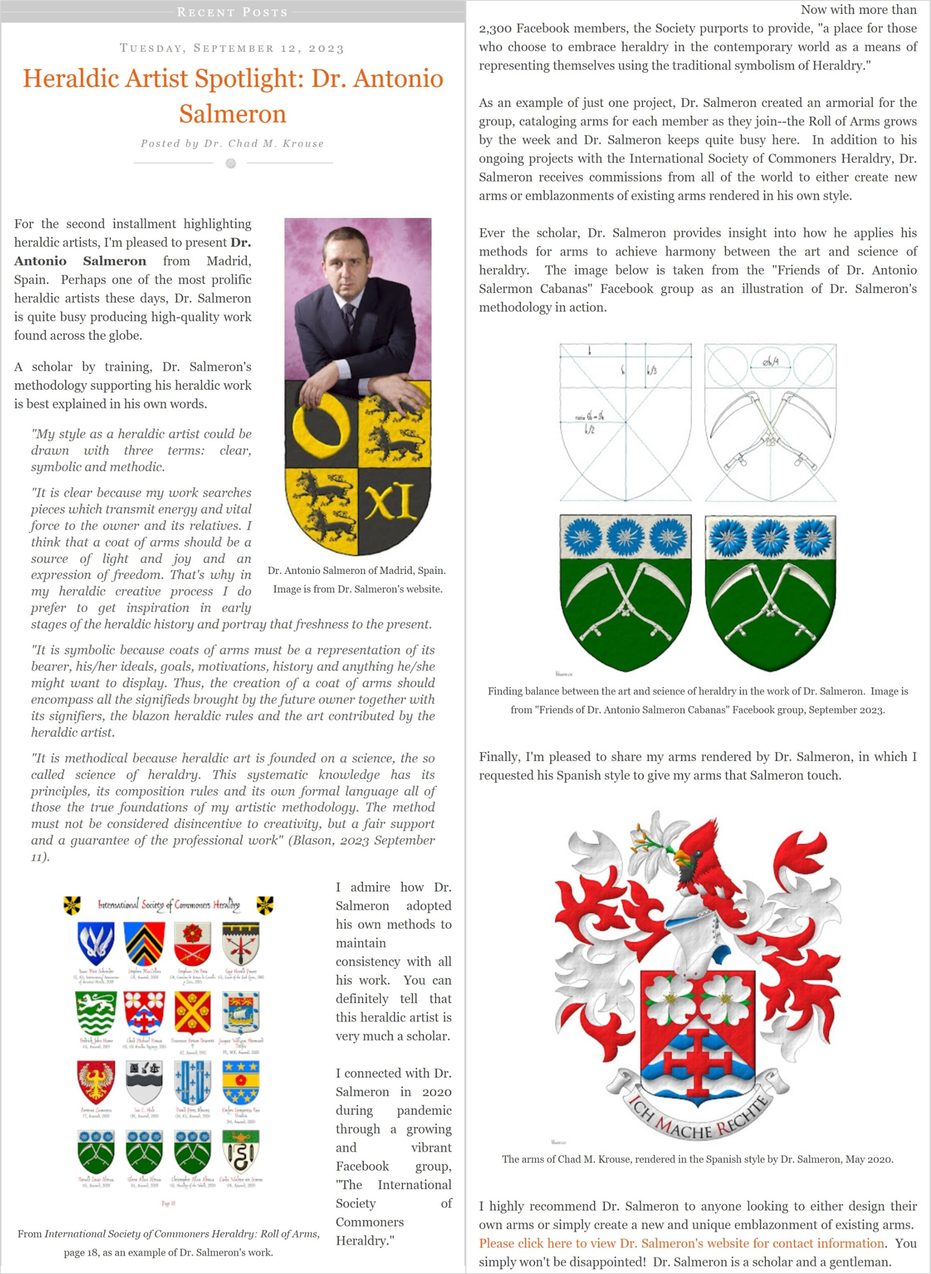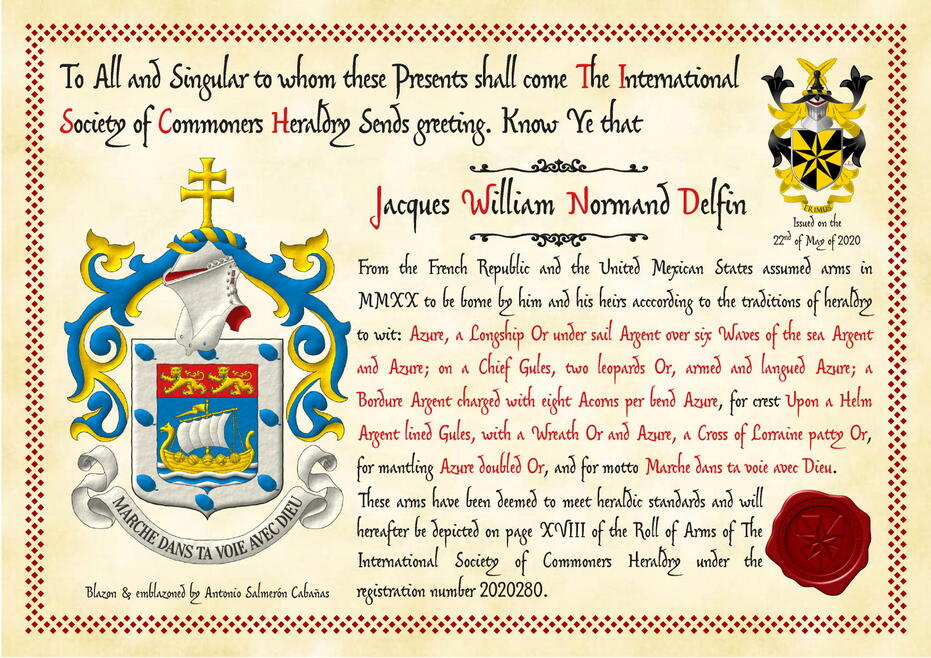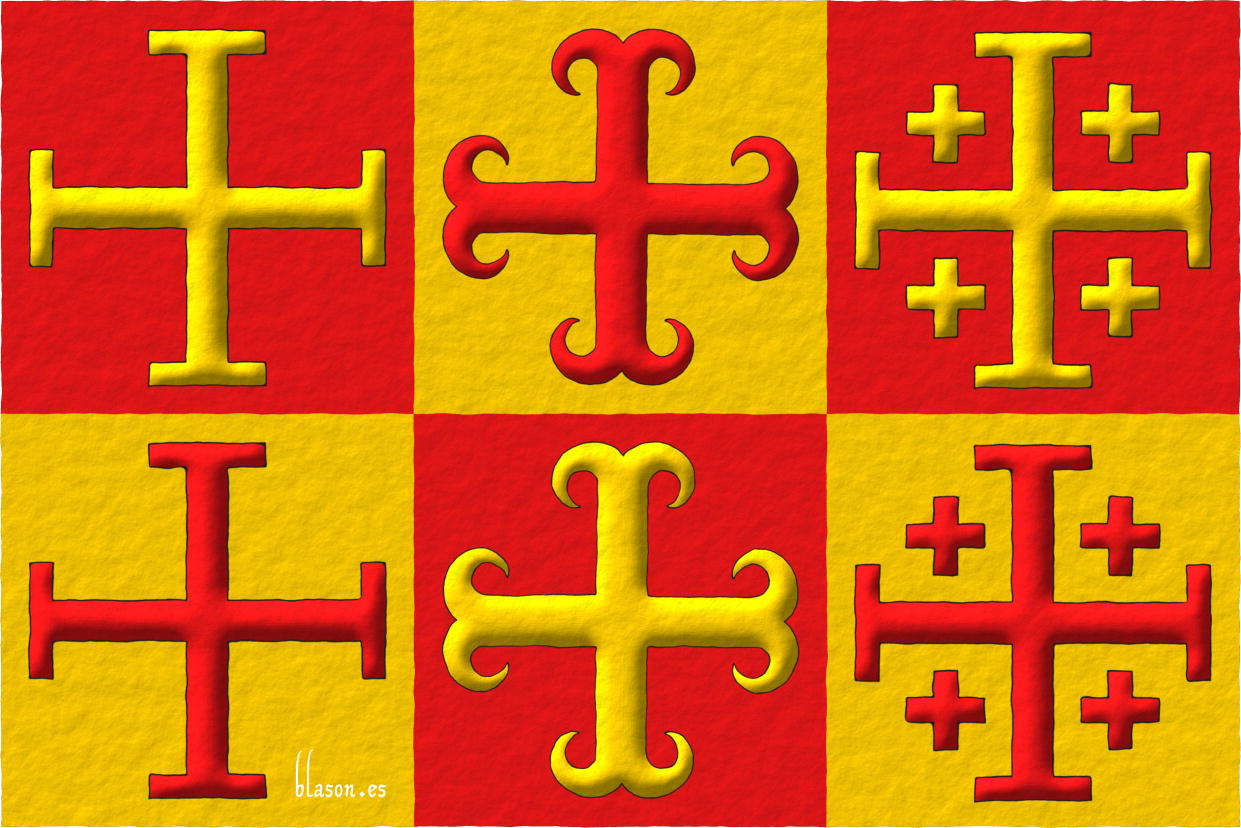Cross couped

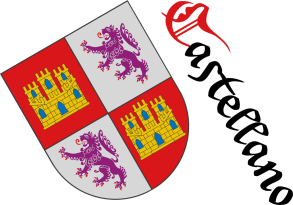
Alcantara, Cavalry Regiment
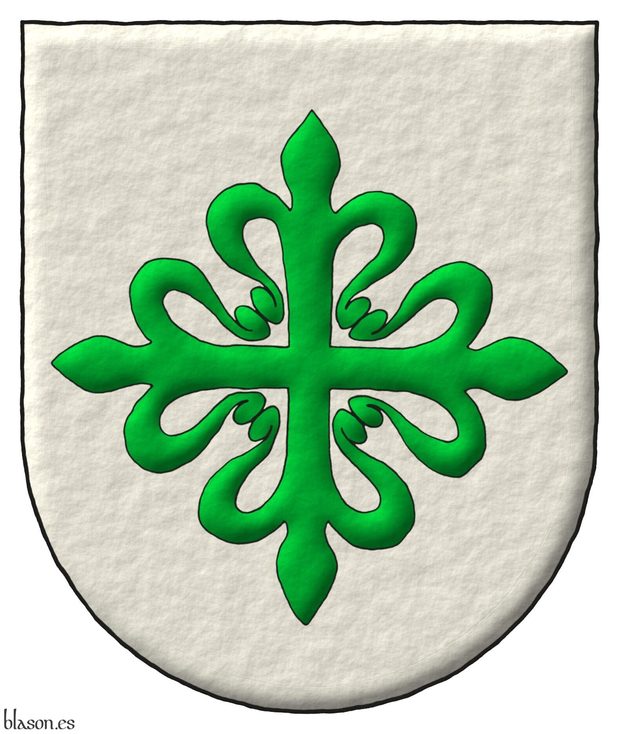
Coat of arms of the Armored Cavalry Regiment Alcantara No. 10, RCAC-10, in 2016.
Argent, a cross of Alcantara.
Escudo de plata, una cruz de Alcántara.
Coat of arms interpreted in the following manner: the shape of the shield is of a semicircular arch; the field is illuminated in the metal Argent; the cross of Alcantara is outlined in Sable and illuminated in Vert; and the whole has a raised stroke finish.
Blazon keywords: Without divisions, Argent, Cross of Alcantara, Cross couped and Cross.
Style keywords: Semi-circular, Illuminated, Outlined in sable and Freehand.
Classification: Interpreted, Military, Army and Navy and Coat of arms.
Bearer: Alcantara, Cavalry Regiment.


![Ver [Alcantara, Order of] en instituciones citadas. Fortaleza de oro y mazonada de sable.](../css/Fortaleza.Institucion.png)
Alcantara, Order of

It was founded by Count Henry of Burgundy as a military and religious order, in the year 1093, in Beira Alta, Portugal, near the river Côa with the initial name of «Ordem de São Julião do Pereiro» ~ Order of Saint Julian of Pereiro.
In the year 1214, the defense of the city of Alcantara after its conquest was entrusted to the Order of Calatrava, but in 1218 the Calatravans relinquished it due to Alcantara being far from Calatrava.
To defend Alcantara, King Alfonso IX of León entrusted it to the new Order of the Knights of Saint Julian of Pereiro, requesting in return a certain level of dependency on the Order of Calatrava, which led the Knights of Saint Julian to adopt the Cistercian rule.
Once established in Alcantara, their original name referring to Saint Julian fell into disuse, and by 1253 there were already references to the «masters of the Order of Alcantara», with Saint Julian of Pereiro becoming the foundational center and a secondary commandery of the order.
On the origin and antiquity of the Military Order of Alcantara, and the form of its Commandery
[Avilés, J.; 1780b; treatise IV, chapter V, page 339] describes it as follows: «The Military Order, which we now call of Alcantara, was formerly that of Saint Julian of Pereiro, so named after the place where it was based, along the banks of the river Côa, in the Bishopric of Ciudad-Rodrigo, established in the year 1176 by King Ferdinand II of León, and confirmed in 1177 by Pope Alexander III. And the reason for changing its first name to the second, was because after the Knights of Calatrava had taken the City of Alcantara from the Moors and defended it bravely thereafter, they found it would be difficult to keep it, as their main house was very distant, from which the other Knights and reinforcements could not come whenever needed.».
[Avilés, J.; 1780b; treatise IV, chapter V, page 340] continues by telling us «They discussed this inconvenience with others they had at the time with the King of León, Don Alfonso IX, and it was resolved that the Master of Calatrava would give that town to the Knights of Pereiro so that they might defend it, as they did, under certain conditions in the year 1218, later performing marvels in its defense, earning through their fame and distinguished feats new graces from the Kings; and seeing how essential their residence was, the Knights of Pereiro moved to the town of Alcantara, establishing their Convent there, and thus transformed into Knights of Alcantara, who were previously Knights of Saint Julian of Pereiro».
Categories: Institution, Interpreted, Religious, Military, Illuminated, Outlined in sable, Freehand, Emblem, Cross of Alcantara, Cross couped and Cross.


Anderson of Erbury
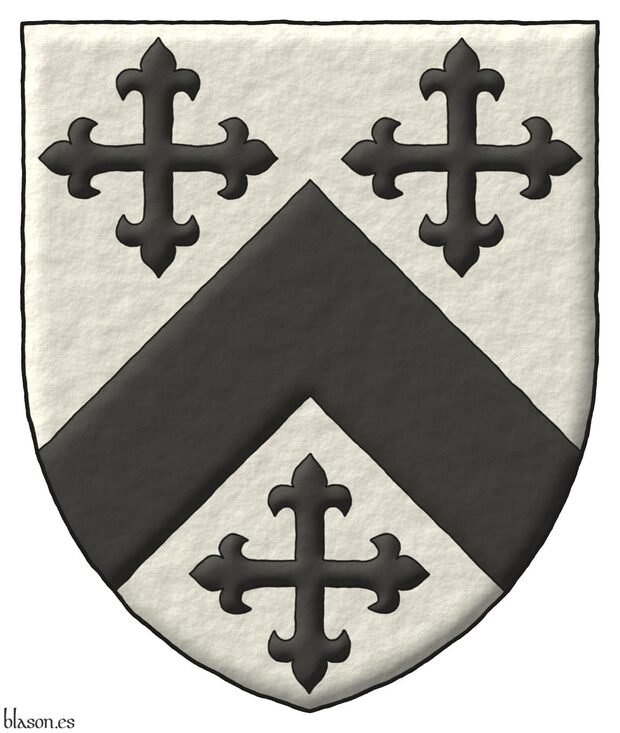
Argent, a chevron between three crosses flory Sable.
Escudo de plata, un cabrio acompañado de tres cruces flordelisadas todo de sable.
Illuminated with lights and shadows and with a freehand finish.
The coat of arms of Anderson of Erbury emblazoned by me in 4 ways: 1) tricking using abbreviations, 2) hatching using lines, 3) plain tinctures, and 4) lights and shados. It is a preliminary artwork for the arms of Nick Allen Rica II.
Blazon keywords: Without divisions, Argent, One, Chevron, Between, Three, Cross flory, Cross couped and Sable.
Style keywords: Freehand, Outlined in sable, Illuminated, Pointed, Tricking, Hatching and Plain tincture.
Classification: Interpreted, Kingdom of Scotland and Schema.
Bearer: Anderson of Erbury.


André de Montbard
Azure, two barbels addorsed Argent. Behind the shield an eight-pointed cross patty Gules.
Blazon keywords: Azure, Two, Barbel, Addorsed, Argent, Behind the shield, One, Eight-pointed cross, Cross couped and Gules.
Style keywords: Outlined in sable, Semi-circular, Illuminated and Freehand.
Classification: Religious, Military, Knights Templar, Interpreted and Coat of arms.
Bearer: Montbard, André de.


Bella, Giovanni de
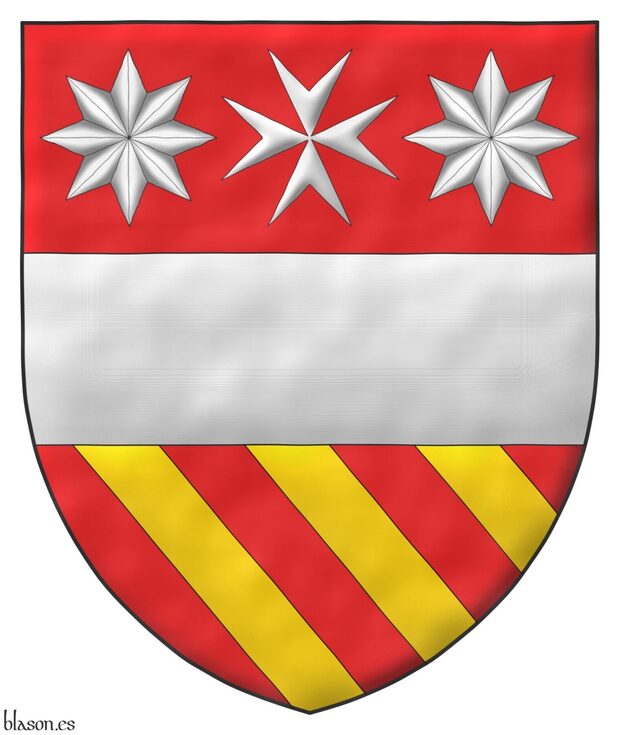
Gules, a fess between, in chief a Maltese cross between two mullets of eight points Argent, in base three bendlets Or.
Coat of arms emblazoned by me with a pointed shape, illuminated, and with a watercolor finishing.
G0053, Chief Herald of Malta's grant of Giovanni de Bella's arms, whose coat of arms has been emblazoned by me.
Blazon keywords: Gules, One, Fess, Between, In chief, Eight-pointed cross, Cross couped, Two, Mullet, Eight, Argent, In base, Three, Bendlet and Or.
Style keywords: Outlined in sable, Illuminated, Watercolor and Pointed.
Classification: Personal, Interpreted and Coat of arms.
Bearer: Bella, Giovanni de.


Bernard de Tremelay
Or, a chief Gules. Behind the shield a cross patty Gules.
Blazon keywords: Or, Chief, Gules, Behind the shield, One, Cross patty and Cross couped.
Style keywords: Outlined in sable, Semi-circular, Illuminated and Freehand.
Classification: Religious, Military, Knights Templar, Interpreted and Coat of arms.
Bearer: Tremelay, Bernard de.


Burgos, University of
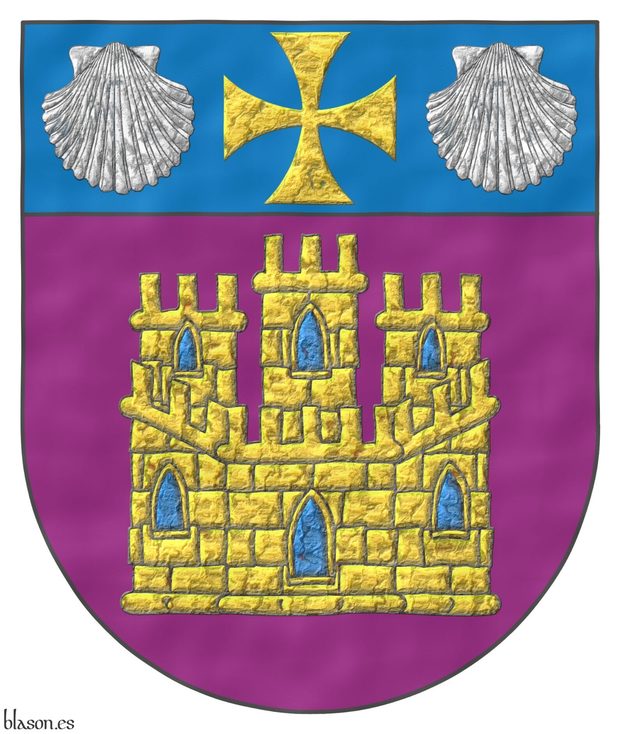
Purpure, a castle triple-towered Or, port and windows Azure, masoned Sable; on a chief Azure, a cross patty Or, between two escallops Argent.
Escudo de púrpura, un castillo de oro, aclarado de azur, mazonado de sable; un jefe de azur, cargado de una cruz patada de oro acompañada de dos veneras de plata.
Coat of arms interpreted with: a semicircular (round) base; the field and the chief watercolored in the flat tinctures Purpure and Azure; and the charges illuminated, outlined in Sable, with a very hammered metal finish.
Although it is a university of recent creation, in 1994, its best-known campus is the so-called Hospital del Rey, located on the edge of the Way of St. James and originally intended to care for pilgrims and founded, in 1195, by Alfonso VIII of Castile and Eleanor Plantagenet. The effigies of both monarchs decorate the main gate of the Hospital, called the Gate of the Pilgrims, which is, in turn, the symbol of the University of Burgos.
Regarding the escallop (venera), [Valero de Bernabé, L.; Márquez de la Plata, V. M.; 2003; page 197] notes that among the wide variety of shells, it is the scallop or pilgrim’s shell that is most used in heraldry and in blazons it is named «venera», and that it is drawn with its concave side against the field and its convex side visible, with its ribs vertical and its ears (auricles) toward the chief of the shield, and that when the concave side is shown one must specify it in the blazon as «alzada», and when the ears are in a different tincture it is said «orejada», for example, «an escallop Or, its ears Gules».
Blazon keywords: Purpure, Or, Azure, Sable, Argent, Castle, Chief, Cross, Cross patty, Cross couped and Escallop.
Style keywords: Semi-circular, Illuminated, Outlined in sable, Watercolor and Hard metal.
Classification: Interpreted, Socioeconomic and Education.
Bearer: Burgos, University of.


Cavalry Regiment Montesa, royal crown
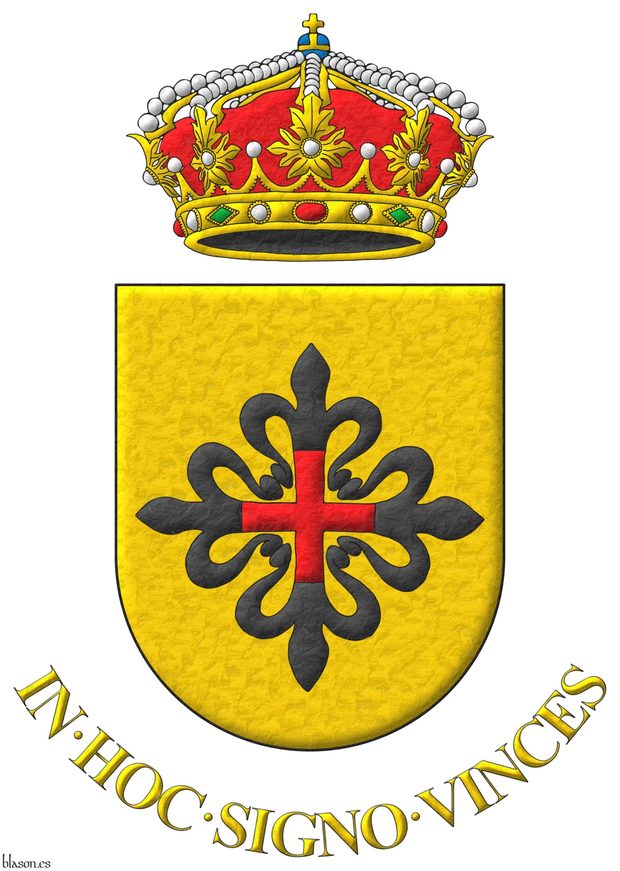
In this sign, you shall conquer.
Argent, a cross of Montesa. Crest: A closed royal crown Or, with eight arches, visible five. Motto: «In hoc signo vinces».
Escudo de oro, una cruz de Montesa. Timbrado de una corona real cerrada. Lema: «In hoc signo vinces».
Coat of arms interpreted as follows: the shape of the shield is a semi-circular arch; the field has been illuminated in metal Or; the cross of Montesa is outlined in Sable and illuminated in Sable and Gules; the royal crown is closed, outlined in Sable and illuminated the metal in Or, the pearls in Argent, the orb in Azure and Or, the gemstones in Gules and Vert, the inner cloth in Gules, and the visible hollow at its base in Sable; and the whole has a slightly beaten metal finish.
Regimental Motto
The Latin motto «In hoc signo vinces» is translated as «In this sign, you shall conquer».
Globus cruciger ~ Orb
It is called orb ~ «globus cruciger», the first in Spanish and the second in Latin, referring to the part of the royal crown, a jewel, or a jewel itself that recreates the shape of the globe topped with a cross.
Blazon keywords: Without divisions, Or, Cross of Montesa, Cross couped, Cross, Crest, Closed royal crown, Crown and Motto.
Style keywords: Semi-circular, Illuminated, Outlined in sable and Soft metal.
Classification: Interpreted, Military, Army and Navy and Coat of arms.
Bearer: Montesa, Cavalry Regiment.


Chad Michael Krouse, collage
Coat of arms painted by me, highlighted with lights and shadows, outlined in Sable, with an ogee outer contour and with a texturized finish.
Dr. Chad M. Krouse in his outstanding blog has graciously spotlighted my contributions to the heraldic arts. He beautifully captures the essence of my work and the methodology behind it. I invite you to read the full article at walsinghamwanderings.blogspot.com/2023/09/heraldic-artist-spotlight-dr-antonio.html and also in his blog walsinghamwanderings.blogspot.com you can see my heraldic artwork at the header of walsinghamwanderings.blogspot.com/2023/09/the-man-and-his-arms-origin-story.html. The image shown is a collage composed of elements from his website.
Blazon keywords: Gules, Argent, Azure, Two, One, Party per chevron, Barry, Wavy, In chief, Dogwood flower, Flower, Proper, In base, Cross of Saint Chad, Cross couped, Crest, Head, Erased, Grasping, Beak, Mantling and Motto.
Style keywords: Outlined in sable, Illuminated and Ogee.
Classification: Personal, Interpreted, Boa and Coat of arms.
Bearer: Krouse, Chad Michael.


Commoners' certification Jacques William Normand Delfin
Azure, on three bars wavy Argent, a Norman ship Or, full sail Argent; on a chief Gules, two leopards Or, armed and langued Azure; a bordure Argent charged with eight acorns bendwise Azure. Crest: Upon a helm with a wreath Or and Azure, a cross of Lorraine patty Or. Mantling: Azure doubled Or. Motto: «Marche dans ta voie avec Dieu».
This is the Commoners' Certification of Arms of Dr. Jacques William Normand Delfin, his arms have been designed by him and me, and emblazoned by me.
Blazon keywords: Azure, Argent, Or, Gules, One, Two, Eight, In base, On, Wavy, Bar, Norman ship, Full sail, Chief, Leopard, Armed, Langued, Bordure, Acorn, Bendwise, Upon (wreath), Helm, Wreath, Cross of Lorraine, Patriarchal cross, Cross couped, Patty, Mantling, Doubled and Motto.
Style keywords: Outlined in sable, Illuminated and Ogee.
Classification: Personal, Created, Boa, Certification, Heraldic document and Flag.
Bearer: Normand Delfin, Jacques William.


Crest and motto of Jan Bobor
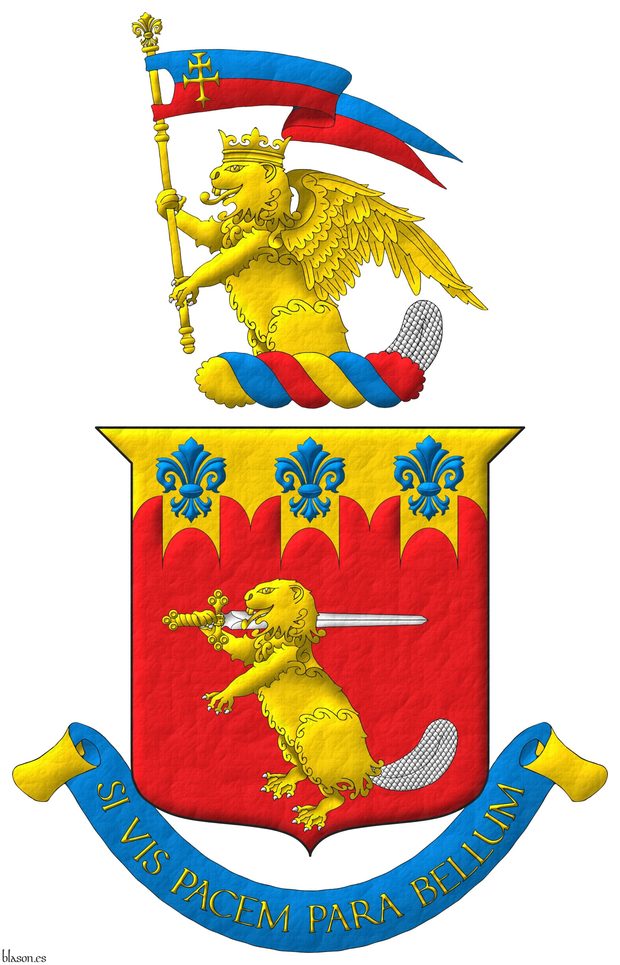
Gules, a beaver erect Or, armed and tailed Argent, bearing on his dexter shoulder a sword Argent, hilted Or; on a chief embattled of Renaissance crenellations Or three fleurs de lis Azure. Crest: Upon a wreath Or, Azure, and Gules a beaver issuant, crowned and winged Or, armed and tailed Argent, holding a pole Or flying a long swallow-tailed flag per fess Azure and Gules, overall a double cross patty fitchy Or. Motto: «Si vis pacem para bellum» Or over a scroll Azure doubled Or.
Coat of arms depicted by me, highlighted with lights and shadows, contoured in Sable, with an ogee external shape and with a watercolor finishing.
Canting arms of Jan Bobor, Slovakia, emblazoned under his directions. These are canting arms, since Bobor means beaver.
Blazon keywords: Gules, Or, Argent, Azure, One, Three, Beaver, Erect, Armed, Tailed, Grasping, Dexter, Shoulder, Sword, Hilted, Chief, Embattled, Fleur de lis, Crest, Wreath, Issuant, Crowned, Winged, Swallow-tail, Party per fess, Overall, Patriarchal cross, Cross couped, Patty, Fitchy, Doubled, Motto and Scroll.
Style keywords: Outlined in sable, Illuminated, Ogee and Watercolor.
Classification: Personal, Interpreted, Boa, Coat of arms, Pennon and Flag.
Bearer: Bobor, Jan.


Cross potent, cross moline, and cross of Jerusalem, comparison
A Gules and Or comparison between cross potent, cross moline, and cross of Jerusalem
Blazon keywords: Gules, Or, Cross potent, Cross couped, Cross moline, Cross of Jerusalem and Cross.
Style keywords: Freehand, Outlined in sable and Illuminated.
Classification: Schema.


Fernández Carrizo, Silvio
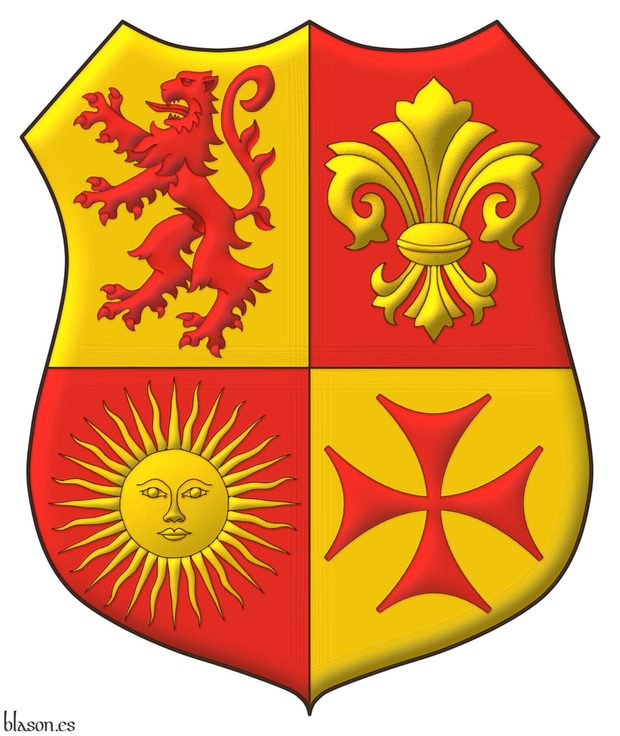
Quarterly: 1 Or, a lion rampant Gules; 2 Gules, a fleur de lis Or; 3 Gules, a sun of May Or; 4 Or, a cross of Bolnisi Gules.
Escudo cuartelado: 1o de oro, un león rampante de gules; 2o de gules, una flor de lis de oro; 3o de gules, un sol de mayo de oro; 4o de oro, una cruz de Bolnisi de gules.
Arms emblazoned by me, highlighted with lights and shadows, contoured in Sable, with a chasuble external shape and with a texturized finish.
Coat of arms of Silvio Fernández Carrizo emblazoned by me.
Blazon keywords: Or, Gules, One, Quarterly, Lion, Rampant, Fleur de lis, Sun of May, Cross of Bolnisi and Cross couped.
Style keywords: Outlined in sable, Illuminated and Chasuble.
Classification: Personal, Interpreted, Boa and Coat of arms.
Bearer: Fernández Carrizo, Silvio.


Full achievement of Jay Geoffrey De Graaf
Party per fess, 1 Gules, a stag rampant, issuant from base proper, in the dexter chief a Maltese cross Argent; 2 Azure, a mullet of seven points Argent. Crest: Upon a helm befitting his degree issuant from a crown of Noble above the shield, with a wreath Argent and Gules, a demi-lion Gules, crowned Or, grasping in its paws a swallow-tailed pennon lozengy Gules and Argent, shafted Sable. Mantling: Gules doubled Argent. Motto: «Per Aquas Ad Futurum». Suspended from the shield, the cross of Knight of Magistral Grace of the Sovereign Military Order of Malta.
Coat of arms painted by me, highlighted with lights and shadows, contoured in Sable, with a pointed external shape and with a freehand finish.
G0131, augmentation of G0042, Chief Herald of Arms of Malta's grant for the arms of Jay Geoffrey De Graaf, Australia. The augmentation consists of the addition of a Maltese cross Argent in the dexter chief. These arms have been emblazoned by me for such grant.
Blazon keywords: Gules, Azure, Argent, Or, One, Party per fess, Stag, Rampant, Issuant from base, Proper, In the dexter chief, Eight-pointed cross, Cross couped, Mullet, Crest, Upon (wreath), Helm, Issuant, Crown of Noble, Crown, Above the shield, Wreath, Demi, Lion, Crowned, Grasping, Paw, Swallow-tail, Lozengy, Shafted, Mantling, Motto, Suspended from the shield and Decoration.
Style keywords: Outlined in sable, Illuminated, Pointed and Freehand.
Classification: Personal, Interpreted, Boa, Coat of arms, Pennon and Flag.
Bearer: Graaf, Jay Geoffrey De.


Gómez Morillo, Antonio José

Argent, a cross patty Gules charged with a double rose Argent and Gules, barbed Vert, seeded Or, between four double roses Gules and Argent, barbed Vert, and seeded Or.
Escudo de plata, una cruz patada de gules cargada de una rosa doble de plata y gules, barbada de sinople y botonada de oro, acompañada de cuatro rosas dobles de gules y plata, barbadas de sinople y botonadas de oro.
Coat of arms emblazoned by me with a shape ended with semi-circular arch, illuminated, and with a leather finishing.
Blazon keywords: Argent, One, Cross patty, Cross couped, Gules, Charged, Double rose, Barbed, Seeded, Between and Four.
Style keywords: Semi-circular, Outlined in sable, Illuminated and Leather.
Classification: Personal, Created and Coat of arms.
Bearer: Gómez Morillo, Antonio José.


Grand collar of the OERC
It has been painted by me, highlighted with lights and shadows, contoured in Sable, and with a metal beaten finishing.
Grand collar of the Ordo Equestris Reginae Caeli emblazoned by me. The humanitarian projects of the OERC mainly include contributions for children and the supply of medical goods in poorer regions of the world.
Blazon keywords: Order, Decoration, Azure, Or, Argent, One, Four, Eight-pointed cross, Cross couped, Fleur de lis, Crowned, Monogram and Grand collar.
Style keywords: Outlined in sable, Illuminated and Metal beaten.
Classification: Interpreted and Boa.
Bearer: Ordo Equestris Reginae Caeli.


Grzeszkowiak, Tomasz Arkadiusz
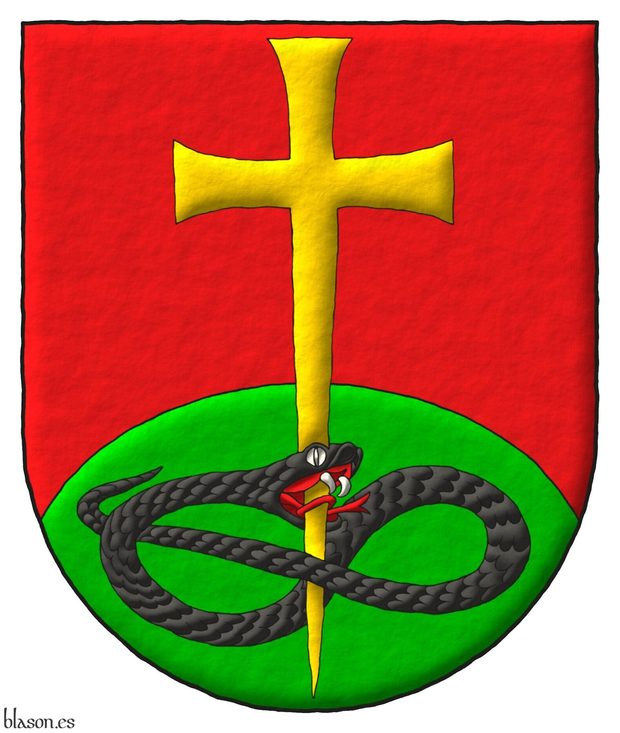
Gules, a base enarched Vert, overall a cross patty fitchy Or, piercing in base the head of a serpent nowed and facing sinister Sable, langued Gules.
I have interpreted this coat of arms with a semi-circular shape; tintures or, sable, vert and gules; outlined with sable; and a freehand finish.
In Polish heraldic tradition the color Sable can be over other colors, the color Vert in this case. The following bibliographical references can be consulted about the Polish use of the color Sable over other colors:
- [Bakala, K.; 2010; page 17] has written «nie pozwala nakladania metalu na metal, a barwy na barwe, za wyjatkiem barwy czarnej i purpurowej» ~ «does not allow to put metal on metal and color on color, except the color Sable and Purpure», notice that Sable and Purpure are the neutral colors whilst Gules, Azure and Vert are energetic colors.
- [Marecki, J.; 2012; page 67] has written about the rule of colors and metals «wyjatkiem byla czern, która laczono zarówno z metalami, jak i z innymi barwami» ~ «the exception was black, which was combined with both metals and other colors».
Blazon keywords: Without divisions, Gules, One, Mount, Vert, Issuant from base, Overall, Cross patty fitchy, Cross couped, Piercing, Head, Serpent, Nowed, Facing sinister, Sable and Langued.
Style keywords: Semi-circular, Freehand and Outlined in sable.
Classification: Interpreted, Personal and Coat of arms.
Bearer: Grzeszkowiak, Tomasz Arkadiusz.


Hatching technique for the arms of the Municipality of Candasnos

Party per fess, the base per pale: 1 Or, a hurt; 2 Gules and 3 Argent, over both a cross of Malta counterchanged.
Escudo cortado y medio partido: 1o de oro, un roel de azur; 2o de gules y 3o de plata, brochante sobre ambos, una cruz de Malta del uno al otro.
Arms interpreted by me, contoured in Sable, and with a texturized finish.
Coat of arms of the municipality of Candasnos, Huesca, designed by Valeriano Labara Ballestar, approved by the Government of Aragon. It has been an honor for me to emblazon this hatching version for Valeriano Labara. [Labara Ballestar, V. C.; 2019; pages 361] «The figure of the Balsa Buena has been represented symbolically and in a stylized manner through a roundel or torteau. This avoids any hint of naturalism, which is so contrary to the art and science of heraldry».
Blazon keywords: Or, Azure, Gules, Argent, One, Party per fess, the base per pale, Hurt, Eight-pointed cross, Cross couped and Counterchanged.
Style keywords: Outlined in sable and Hatching.
Classification: Civic, Interpreted, Design rationale, Boa and Coat of arms.
Bearer: Candasnos, municipality of.


Heikki Halkosaari, plain tincture
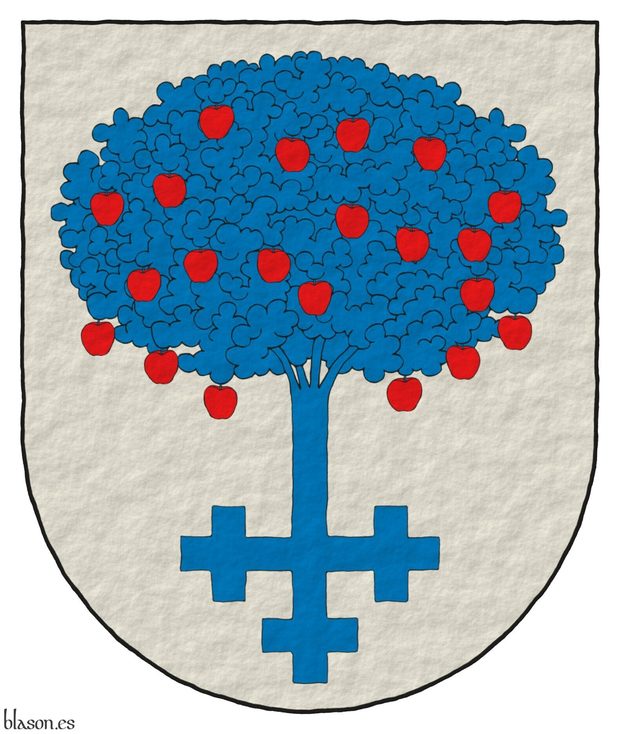
Argent, an apple tree, the base of its trunk forming a cross crosslet Azure, fructed Gules.
Arms interpreted by me, in flat tinctures, outlined in Sable, with a semi-circular outer contour and with a texturized finishing.
The coat of arms of Heikki Halkosaari, Finland, emblazoned by me.
Blazon keywords: Argent, Azure, Gules, One, Apple tree, Base, Trunk, Cross, Crosslet, Cross couped and Fructed.
Style keywords: Outlined in sable, Plain tincture and Semi-circular.
Classification: Personal, Interpreted, Boa and Coat of arms.
Bearer: Halkosaari, Heikki.


Henry of Castile, Infante
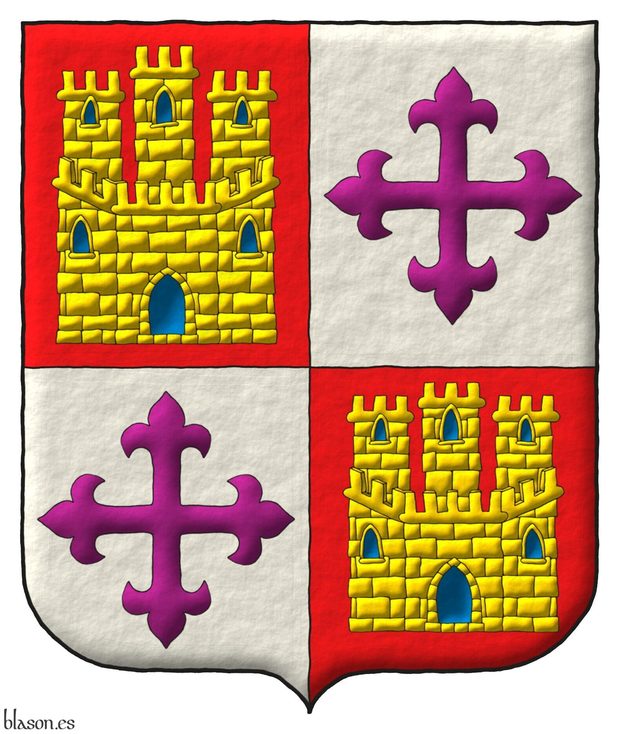
Quarterly: 1 and 4 Gules, a castle triple-towered Or, port and windows Azure, and masoned Sable; 2 and 3 Argent, a cross flory Purpure.
Escudo cuartelado: 1o y 4o de gules, un castillo de oro, aclarado de azur, mazonado de sable; 2o y 3o de plata, una cruz flordelisada de púrpura.
Coat of arms emblazoned by me, illuminated with lights and shadows, contoured in Sable, with an ogee external shape and with a freehand finish.
Coat of arms of the Infante Henry of Castile, 1230–1303, 6th offspring of the King Ferdinand III of Castile, 1199-1252, and the Queen Beatrice of Swabia, 1205–1235. He bore his father's arms, replacing the lion Purpure of the Kingdom of León with a cross flory Purpure, likely due to his close association with the Order of Calatrava, whose emblem is a cross flory Gules. However, he retained the metal Argent field in the 2nd and 3rd quarters and the lion's purpure color, suggesting this was more of a conceptual change than a quartering by alliance with the Order of Calatrava.
Blazon keywords: Gules, Or, Azure, Sable, Argent, Purpure, One, Quarterly, Castle, Triple-towered, Port and windows, Masoned, Cross flory and Cross couped.
Style keywords: Outlined in sable, Illuminated, Ogee and Freehand.
Classification: Personal, Kingdom of Castile and Leon, Interpreted, Boa and Coat of arms.
Bearer: Henry of Castile, Infante.


Infante Manuel of Castile, schema 3x4
In Castile, a coat of arms quarterly does not necessarily signify inheritance. This schema illustrates two practices: a) Quarterings can represent the mother in the 1st and 4th quarters and the father in the 2nd and 3rd, highlighting the prominence given to the maternal line by placing it in the most visible quarters. b) Quarterings can also include personal symbols and concepts, like canting arms, for example, «Manuel» =«mano» + «ala» = «hand» + «wing», combined with ancestral arms. This flexibility reflects Castilian heraldic traditions, where arms are not strictly marshalled by inheritance. The inclusion of maternal arms in the 1st and 4th quarters highlights how Castilian heraldry often elevates maternal heritage, differing from some other heraldic traditions. The previous commentary emphasizes the creative freedom in Castile, where quartering could incorporate personal symbols or canting arms without the constraints of inheritance or dominium. This flexibility aligns with Castilian culture, allowing heraldry to reflect personal identity, not just dynastic ties. Notably, the arms of Infante Enrique's use of a cross flory demonstrates this creative freedom, showcasing the ability to innovate within heraldry even in royal contexts. While this might seem unconventional compared to other heraldic systems, it is deeply rooted in Castilian tradition. All coats of arms in this schema have been emblazoned by me.
Blazon keywords: Argent, Purpure, Gules, Or, Azure, Sable, One, Quarterly, Lion, Rampant, Armed, Langued, Castle, Triple-towered, Port and windows, Masoned, Bordure, Compony, Eagle, Cross flory, Cross couped, Party per pale, Hand, Arm, Vambraced, Embowed, Winged, Sword, Point upwards and Hilted.
Style keywords: Outlined in sable, Illuminated and Ogee.
Classification: Personal, Kingdom of Castile and Leon, Interpreted, Design rationale, Schema, Boa and Coat of arms.
Bearer: Manuel of Castile, Infante.


Jacques de Molay
Azure, a bend Or. Behind the shield an eight-pointed cross patty Gules.
Blazon keywords: Azure, One, Bend, Or, Behind the shield, Eight-pointed cross, Cross couped and Gules.
Style keywords: Outlined in sable, Illuminated, Semi-circular and Freehand.
Classification: Religious, Military, Knights Templar, Interpreted and Coat of arms.
Bearer: Molay, Jacques de.


Jamilena, province of Jaen
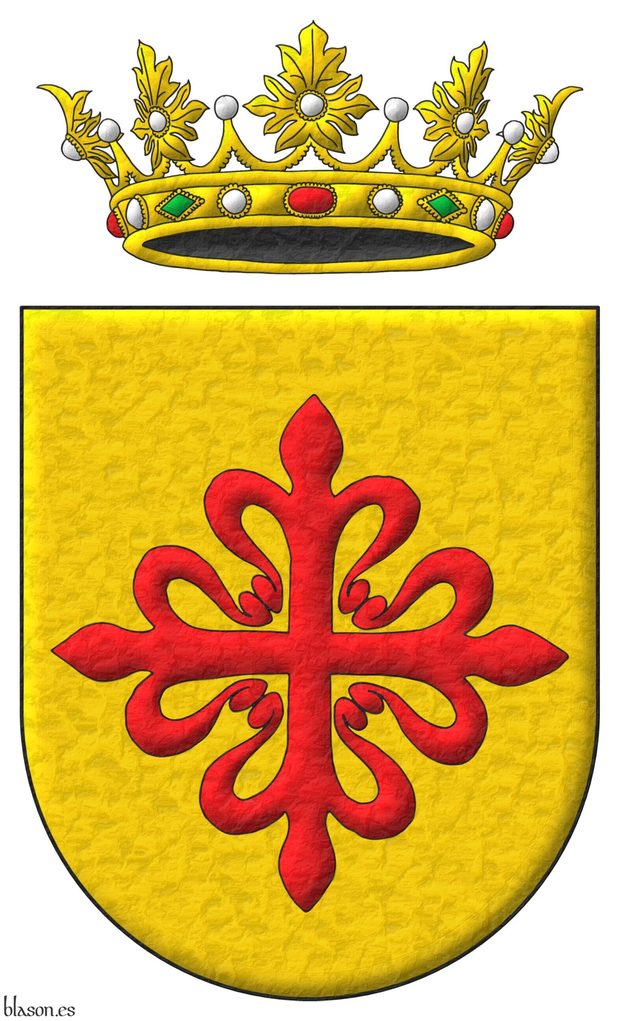
Or, a cross of Calatrava. Crest: An open royal crown Or.
Escudo de oro, una cruz de Calatrava. Timbrado de una corona real abierta.
Coat of arms interpreted as follows: the shield's shape is a semicircular arch; the field is illuminated in metal Or; the cross of Calatrava is outlined in Sable and illuminated in Gules; the royal crown is open, outlined in Sable and illuminated in metal Or, pearls in Argent, gemstones in Gules and Vert, and the visible base hollow in Sable; and the entire piece has a slightly hammered metal finish.
The municipality of Jamilena belongs to the La Campiña region and is the smallest in the province of Jaén. I have depicted its coat of arms with an open royal crown, but representations with a closed royal crown can also be found.
The origin of the cross of Calatrava in its heraldic coat of arms dates back to the year 1525 when Emperor Charles V issued several decrees from Toledo to build a convent for nuns in Jamilena. For the construction of this convent, stones from the Muslim castle, which was reformed and occupied by the Order of Calatrava, were used.
Blazon keywords: Without divisions, Or, Cross of Calatrava, Cross couped, Cross, Crest, Open royal crown and Crown.
Style keywords: Semi-circular, Illuminated, Outlined in sable and Soft metal.
Classification: Interpreted, Civic and Coat of arms.
Bearer: Jamilena.


Kathleen Kane, sealed
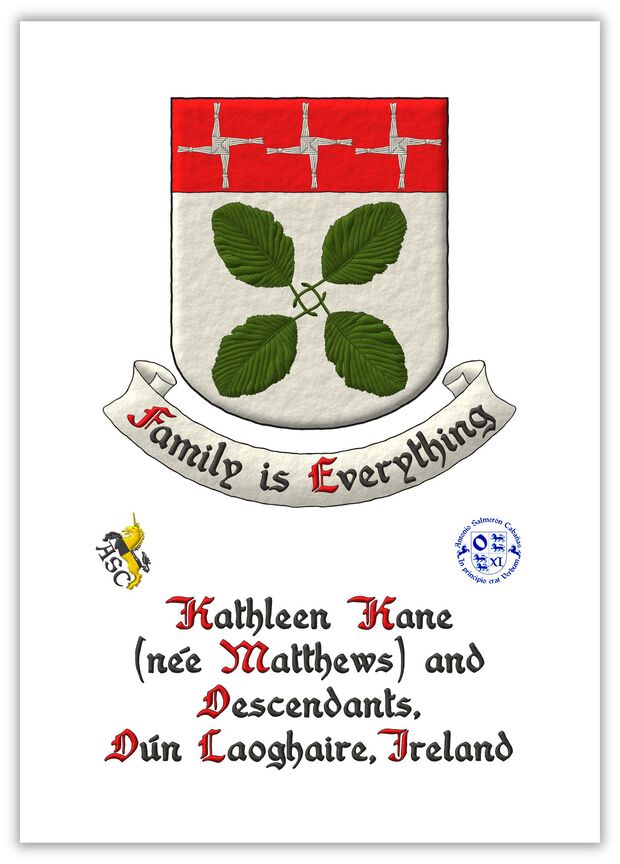
Argent, four leaves of silver-leaved whitebeam (Sorbus Aria Lutescens) in saltire, stems interlaced Vert, on a chief Gules, three crosses of Saint Brigid Argent. Motto: «Family is Everything» Sable, with initial letters Gules, over a scroll Argent.
Design rationale
Kathleen Kane's three recent matrilineal ancestors were all named after the Irish Saint Brigid of the 5th and 6th centuries. With the time, this saint added to her own story some of the characteristics of her namesake, the earlier Celtic goddess of water, poetry, and the alchemical force of fire. She is one of the patron saints of Ireland and her Feast Day is February 1st.
These three women were formidable characters: resilient, resourceful, and independent. Each inspired their daughters to follow in their footsteps, reflecting the attributes associated with Saint Brigid, an icon of strength, piety, resourcefulness, and independence. They are symbolized by the three crosses of Saint Brigid.
Saint Brigid's Crosses, woven from straw or rushes and blessed, are traditionally hung in the rafters or beams of the house to ensure the saint's protection throughout the year for all household members. This symbolism connects the matrilineal ancestors with the home and the protection of the family, which, according to the motto, is everything.
The four leaves of the Silver Leaved Whitebeam represent Kathleen's four children. The interlaced stems symbolize the union of the family and their home in Dún Laoghaire, outside of which this tree grows.
Blazon keywords: Argent, Four, Leaf, In saltire, Stem, Interlaced, Vert, Chief, Gules, Three, Cross of Saint Brigid and Cross couped.
Style keywords: Outlined in sable and Rounded.
Classification: Personal, Interpreted, Coat of arms, Design rationale, Sealed arms and Heraldic document.
Bearer: Kane, Kathleen.


King Arthur, banner with cross flory
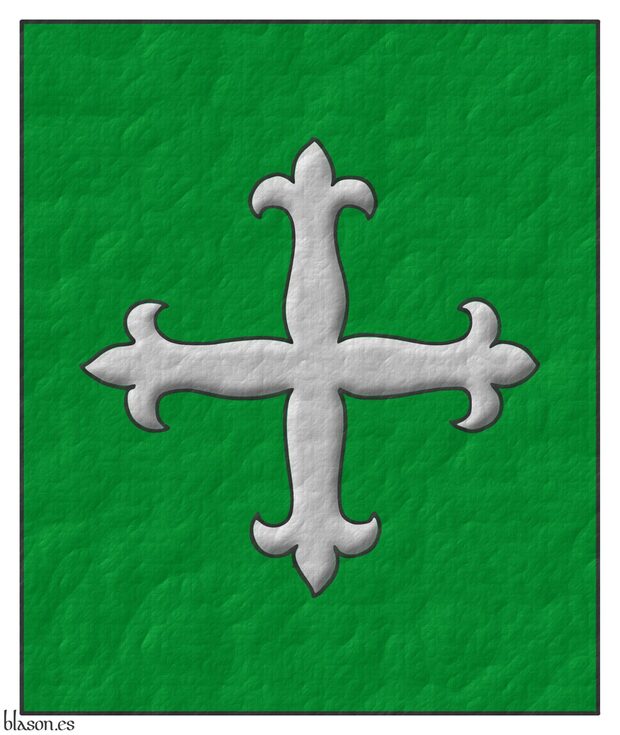
Banner Vert, a cross flory Argent.
Pendón de sinople, una cruz flordelisada de plata.
Imaginary banner interpreted in the following way: the banner has a 5x6 proportion; the field has been enameled with flat color Vert; the cross flory is illuminated Argent and outlined in Sable; and the finish is cloth-like.
This banner appears in [Edward IV of England; 1461; row 15, 1st column].
Blazon keywords: Without divisions, Vert, Argent, Cross flory and Cross couped.
Style keywords: Rectangular, Illuminated, Outlined in sable and Fabric.
Classification: Interpreted, Imaginary, Flag, Banner of arms and Kingdom of England.
Imaginary bearer: Arthur of Britain.


Kingdom of Jerusalem
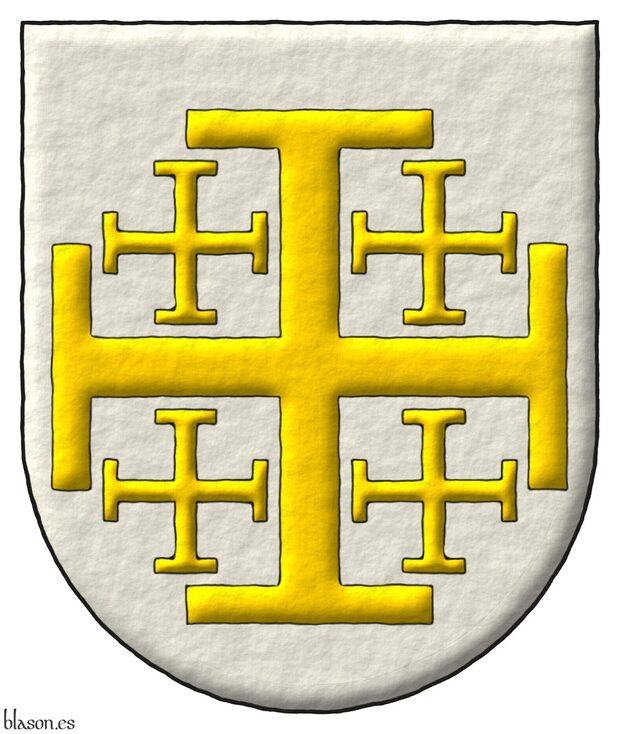
Metal Or over metal Argent.
Argent, a cross potent cantoned of four crosslets potent Or.
Escudo de plata, una cruz potenzada cantonada de cuatro cruces potenzadas todas de oro.
Illuminated with lights and shadows and with a freehand finish.
Perhaps the most classic example of non-compliance with the heraldic rule of tinctures having metal Or over metal Argent. In [Galdiano L.; Century XVII; folio 6], you can see a version of the arms of Jerusalem with the field in Gules, which would indeed follow the rule of tinctures as it is metal on color.
Blazon keywords: Without divisions, Argent, One, Cross potent, Cross couped, Cantoned, Four and Or.
Style keywords: Freehand, Outlined in sable, Illuminated, Semi-circular and Metal on metal.
Classification: Interpreted and Civic.
Bearer: Kingdom of Jerusalem.


Liu-Lecomble, Laurent
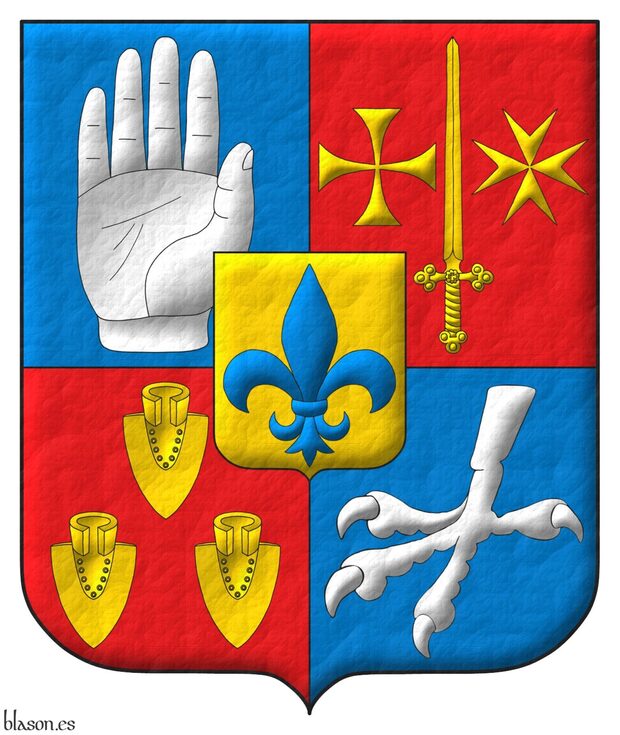
Quarterly: 1 Azure, a dexter hand appaumée Argent; 2 Gules, a sword point upwards between, in the dexter, a cross patty, and, in the sinister, a Maltese cross Or; 3 Gules, three plough shares affronty, downwards, and disordered Or; 4 Azure, an eagle claw, couped Argent; an inescutcheon Or charged with a fleur de lis Azure.
Escudo cuartelado: 1o de azur, una mano diestra apalmada de plata; 2o de gules, una espada alzada acompañada, a la diestra, de una cruz patada y, a la siniestra, de una cruz de Malta, todo de oro; 3 de gules, tres rejas de arado de frente, bajadas y desordenadas de oro; 4 de azur, una garra de águila, cortada, bajada de plata; un escusón de oro cargado de una flor de lis de azur.
Coat of arms depicted by me, highlighted with lights and shadows, contoured in Sable, with an ogee outer contour and with a leather finish.
Coat of arms of Laurent Liu-Lecomble designed by him and emblazoned by me.
Blazon keywords: Azure, Argent, Gules, Or, One, Three, Quarterly, Dexter, Hand, Appaumée, Sword, Point upwards, Between, Cross patty, Cross couped, Sinister, Eight-pointed cross, Plough share, Affronty, Disordered, Eagle claw, Inescutcheon, Charged and Fleur de lis.
Style keywords: Outlined in sable, Illuminated, Ogee and Leather.
Classification: Personal, Interpreted, Boa and Coat of arms.
Bearer: Liu-Lecomble, Laurent.


Nilda Ernestina Lucca de Anaya
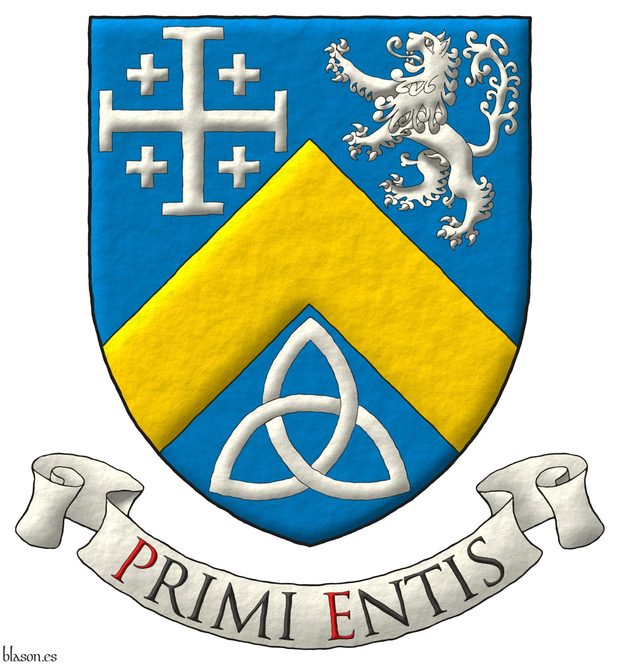
Azure, a chevron Or, between in chief a cross potent cantoned of crosslets, and a lion rampant, and in base a Celtic Trinity knot Argent. Motto: «Primi entis» Sable, with initial letters Gules, over a scroll Argent.
Escudo de azur, un cabrio de oro, acompañado en jefe de una cruz potenzada cantonada de cuatro cruces, y un león rampante, en punta de un nudo celta de la Trinidad, todo de plata. Lema: «Primi entis» de sable, con iniciales de gules, sobre una filacteria de plata.
Design rationale
The Cross of the Episcopal Church, a lion because of the city of Ponce, Puerto Rico, a Holy Spirit symbol, the tinctures of Anaya Argent, Or, and Azure, and her motto for being the first woman ordained as a priest in the Episcopal Anglican Church in Latin America, and one of the first in the United States of America.
Credits:
- Ernesto Juan Anaya is the designer of the coat of arms.
- Antonio Salmerón y Cabañas is the author of the heraldic art.
Blazon keywords: Azure, One, Chevron, Or, Between, In chief, Cross of Jerusalem, Cross couped, Cross potent, Cantoned, Four, Crosslet, Lion, Rampant, In base, Celtic Trinity knot, Knot, Celtic, Trinity, Scroll, Charged and Motto.
Style keywords: Outlined in sable, Illuminated, Pointed and Freehand.
Classification: Religious, Interpreted, Coat of arms, Latin language and Design rationale.
Bearer: Lucca de Anaya, Nilda Ernestina.


Nilda Ernestina Lucca de Anaya, The Armorial Register
Registered by The International Register of Arms, 6th of June of 2020, Registration number 0559, Volume 4.
Categories: Armorial roll, Azure, Chevron, Between, In chief, Cross of Jerusalem, Cross couped, Cross potent, Cantoned, Crosslet, Lion, Rampant, In base, Celtic Trinity knot, Knot, Celtic, Trinity and Scroll.
External resource:
Root: The Armorial Register.


Noblemen of Navarre
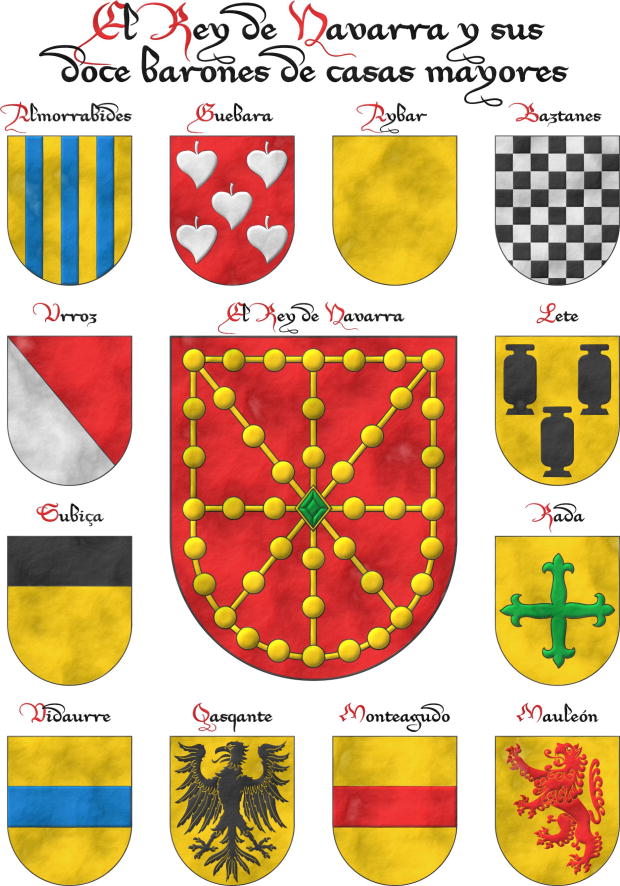
The King of Navarre, at the time of his new and solemn coronation, is raised and lifted up as King by the hands of twelve barons of the greatest and oldest houses of the said Kingdom, and these are the twelve Noblemen who are named on the other side, with their blazons and coats of arms.
Interpretation and composition of 13 coats of arms that I have created with a parchment-like finish.
A free interpretation, for example, without the central crown over the arms of Navarre, with a different title, written «Navarra» and not «Nabarra», etc., based on the principal plate of [Bosque, J. del; 1540; folio 1 of the numbering of 1613] and with texts taken from the transcription by [Martinena Ruiz, J. J.; 1982; pages 122 and 123].
«Ricohombre», written together, currently means «title that formerly belonged to the highest nobility of Spain», [Real Academia Española; 2001].
Its plural «ricoshombres» is the most commonly used form, but «ricohombres» is also correct and used; and in [Bosque, J. del; 1540] it is written separately, and «honbre» with an «n» before the «b», that is, «ricos honbres».
Blazon keywords: Without divisions, Party per bend, Azure, Gules, Or, Argent, Sable, Vert, Eagle, Chequey, Cross flory, Cross couped, Fess, Chief, Lion, Pale, Poplar leaf, Clay pot and Rampant.
Style keywords: Semi-circular and Old parchment.
Classification: Interpreted and Kingdom of Navarre.
Bearer: Noblemen of Navarre.


o-XI, heraldic document
Heraldic document, 2 pages.
The pages have a heraldic frame with the elements of his coat of arms.
The motto, which is the beginning of the Gospel of Saint John, can be seen in [Cnut Gospels; 1020; folio 111].
Blazon keywords: Quarterly, Sable, Or, One, Letter, Two, Wolf, Passant, In pale, Number, Gules, Argent, Azure, Crest and mantling, Helm, Mantling, Wreath, Crest, On, Charged, Disordered, Cross, Cross of Burgundy, Cross couped, Book, Open, Motto, Scroll and Fimbriated.
Classification: Created, Personal, Catalogue, Heraldic document and Frame.
Bearer: Salmerón Cabañas, Antonio.


Order of Calatrava, emblem
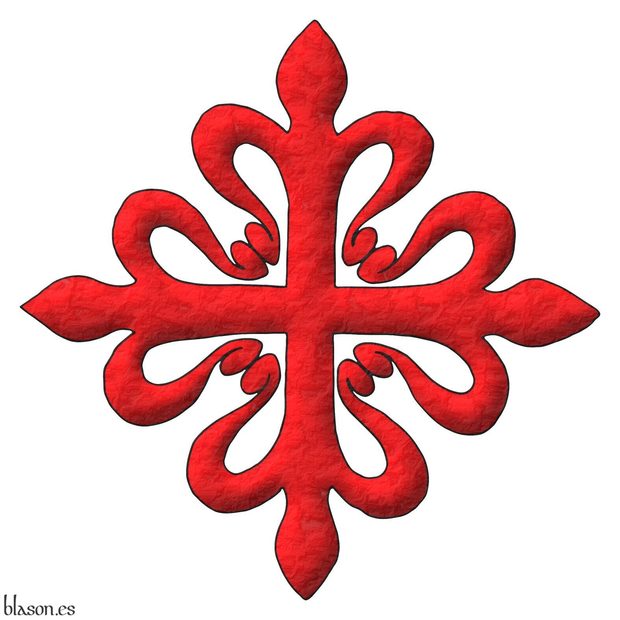
Order of Chivalry of Calatrava
A cross of Calatrava.
Una cruz de Calatrava.
Interpretation of the emblem of the order with: its cross outlined in Sable, illuminated in Gules; and a heavily beaten metal finish.
The Royal Council of the Orders of Chivalry of Santiago, Calatrava, Alcantara, and Montesa, in its historical review of the foundation of the Order of Calatrava, states that it was founded during the reign of Sancho III of Castile in the 12th century.
After the Templars withdrew from the defense of the town, King Sancho III proposed in Toledo and later confirmed in Almazán, in January 1158, the perpetual donation of the town of Calatrava to Raymond, then Abbot of the Cistercian monastery of Fitero, who, together with the former soldier Diego Velázquez, committed to defending it from attacks by the Almohads. For this mission, they received financial support from the Archbishop of Toledo, Juan, and from Toledo itself, thus managing to form an army of more than 20,000 men.
Emblem
Regarding the emblem of the Order of Chivalry of Calatrava [Avilés, J.; 1780b; treatise IV, chapter IV, page 338, figure 102] it states «the Seal was always a red cross with blue straps, and the Banner originally bore a black Cross; but today they use the red cross florety, bordered with eight circles, placed side by side, and joined at the center, formed by a cord that emerges from the leaves of the flower, which Benedict XIII gave (while recognized in Spain) and which is the Commandery that the Knights of this Order wear on their chest today, or hanging from a red ribbon on a gold medal; that is, on a field of Or a cross of Gules».
Blazon keywords: Cross of Calatrava, Cross couped and Cross.
Style keywords: Illuminated, Outlined in sable and Soft metal.
Classification: Interpreted, Religious, Military and Emblem.
Bearer: Calatrava, Order of.


Order of Mercy, pointed and rounded
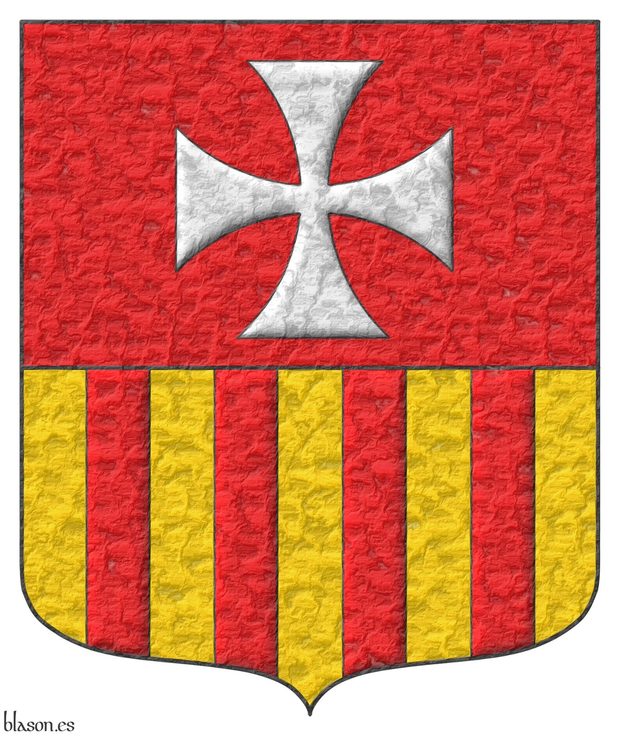
Order founded in 1218 by Saint Peter Nolasco.
Party per fess: 1 Gules, a cross patty Argent; 2 Or, four pallets Gules.
Escudo cortado: 1o de gules, una cruz patada de plata; 2o de oro, cuatro palos de gules.
Already existing arms interpreted by me in the following way: the mouth of the coat of arms is pointed and rounded; its field has been enameled with Gules and Or flat tinctures; the cross patty and the 4 pales are illuminated; and the whole coat of arms has a hammered metal finish.
Blazon keywords: Party per fess, Gules, Or, Argent, Cross, One, Cross patty, Cross couped and Pale.
Style keywords: Ogee, Illuminated, Outlined in sable and Metal beaten.
Classification: Interpreted, Religious and Coat of arms.
Bearer: Our Lady of Mercy, Order of.


Order of Montesa, emblem
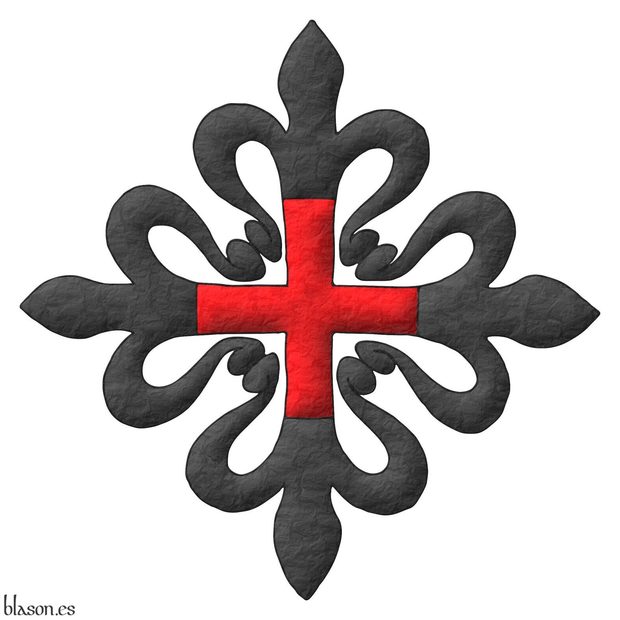
Order of Chivalry of Saint Mary of Montesa and Saint George of Alfama.
A cross of Montesa.
Una cruz de Montesa.
Interpretation of the emblem of the order with: its cross outlined in Sable, illuminated in Gules; and a highly hammered metal finish.
The Royal Council of the Orders of Chivalry of Santiago, Calatrava, Alcantara, and Montesa, in its historical review of the founding of the Order of Montesa, states that it was created in 1317, at the request of James II, King of Aragon, through a bull issued by Pope John XXII.
Emblem
About the emblem of the Order of Chivalry of Montesa [Avilés, J.; 1780b; treatise IV, chapter VI, page 342, figure 103], it states that «the Ensign of the Knights of Montesa is a plain red Cross», gules, «plain, which they wear on their Capitular Mantles, or hanging from a red ribbon on the chest over a gold oval; that is, on a field of gold a plain cross of gules (different from how the Masters wore it)» and, therefore, it describes the first emblem of the Order of Montesa and not the one they wear now, which is that same plain cross of gules charged on a cross like that of the Order of Calatrava or like that of the Order of Alcantara, but in Sable instead of Gules or Vert.
Blazon keywords: Cross of Montesa, Cross couped and Cross.
Style keywords: Illuminated, Outlined in sable and Soft metal.
Classification: Interpreted, Religious, Military and Emblem.
Bearer: Montesa, Order of.


Order of Santiago, emblem
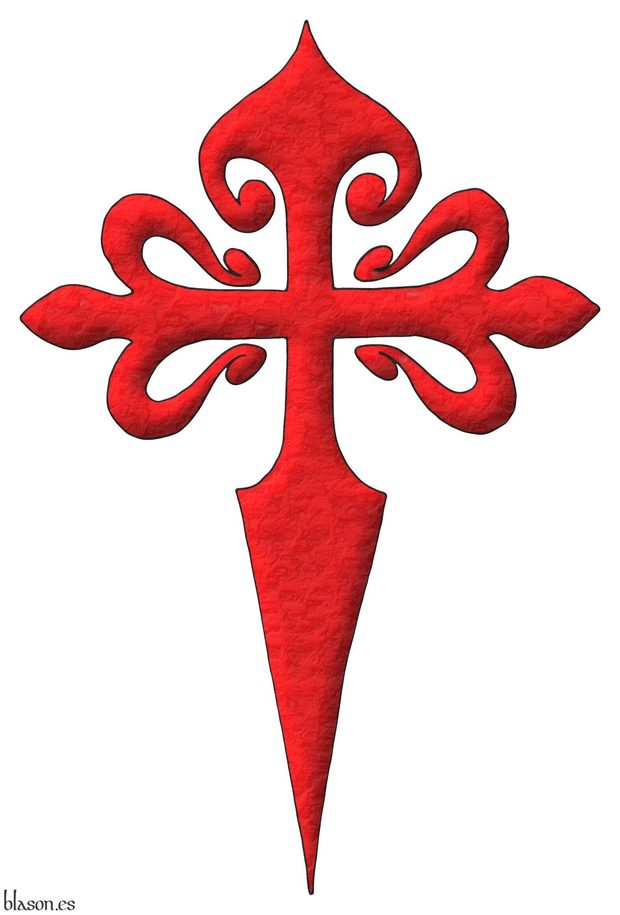
Order of Chivalry of Santiago
A cross of Saint James.
Una cruz de Santiago.
Interpretation of the emblem of the order with: its cross outlined in Sable, illuminated in Gules; and a heavily hammered metal finish.
The Royal Council of the Orders of Chivalry of Santiago, Calatrava, Alcantara, and Montesa, in its historical account of the foundation of the Order of Santiago, describes three different points of view:
- The one presented by tradition, which establishes it in 844, after the battle of Clavijo, when fourteen knights led by the Field Master Don Sancho Martínez de Tejada requested permission from Don Ramiro I, king of Asturias between the years 842 and 850, to found it. This traditional view is the one recorded in [Avilés, J.; 1780b; treatise IV, chapter II, page 325] when discussing the origin of the «Military Order of Santiago of the Sword».
- The perspective of historians like Claudio Sánchez Albornoz or Américo Castro, who question the earlier date. Furthermore, [Sánchez Albornoz, C.; 1965; pages 94-136], as cited in [Domínguez García, J.; 2008; pages 69-70], proposes that the actual battle of Clavijo occurred later, in the year 859, and that Ramiro I did not participate, but rather it was a conflict between King Ordoño I and the Moor Muza.
- The view of historians who, based on the statutes of the order found in the Monastery of Uclés, which was the residence of the Master of the Order of Santiago, and the Latin in which they are written, believe that the foundation could indeed date back to the reign of Don Ramiro I.
Emblem
Regarding the emblem of the Order of Chivalry of Santiago, [Avilés, J.; 1780b; treatise IV, chapter II, page 328, plate 25, figure 100] states «the Commandery of this Order was always a red Sword» (gules ~ red), «in the form of a Cross, just as the guards of the ancient Swords that its Knights and Commanders carried on their white Mantles, and today also on the chest in the same manner, hanging from a red ribbon on a gold medal; that is, in a field of Or, a Cross of Gules».
Blazon keywords: Cross of Saint James, Cross couped and Cross.
Style keywords: Illuminated, Outlined in sable and Soft metal.
Classification: Interpreted, Religious, Military and Emblem.
Bearer: Santiago, Order of.


Province of Cáceres with Cross of Alcántara

Party per pale: 1 Gules, a castle triple towered Or, port and windows Azure, masoned Sable; 2 Argent, a lion rampant Purpure, armed and langued Gules, crowned Or. Crest: An open royal crown. Behind the shield a cross of Alcantara.
Escudo partido: 1o de gules, un castillo de oro, aclarado de azur, mazonado de sable; 2o de plata, un león rampante de púrpura, armado y lampasado de gules, coronado de oro. Timbrado de una corona real abierta. Acolada detrás del escudo una cruz de Alcántara.
Civic coat of arms interpreted by me as follows: the shield of arms has a semicircular (round) base; the quarters are enameled and illuminated in the tinctures Argent and Gules; the castle, the lion, the Cross of Alcántara and the crown are illuminated; the lion and its crown are outlined in the colour of the field; the open royal crown, the Cross of Alcántara and the castle are outlined in Sable; the Cross of Alcántara is fimbriated Or; and the whole has a watercolor finish.
In [Medél, R.; 1846; plate 35, illustration 5] one can see his interpretation of the Cross of Alcántara.
Blazon keywords: Argent, Purpure, Gules, Or, Azure, Party per pale, Castle, Lion, Port and windows, Masoned, Rampant, Armed, Langued, Crowned, Crest and mantling, Crown, Open royal crown, Behind the shield, Cross, Cross of Alcantara and Cross couped.
Style keywords: Semi-circular, Illuminated and Watercolor.
Classification: Interpreted, Civic and Coat of arms.
Bearer: Cáceres, Province of.


Quartered arms of Bertrand de Blanchefort
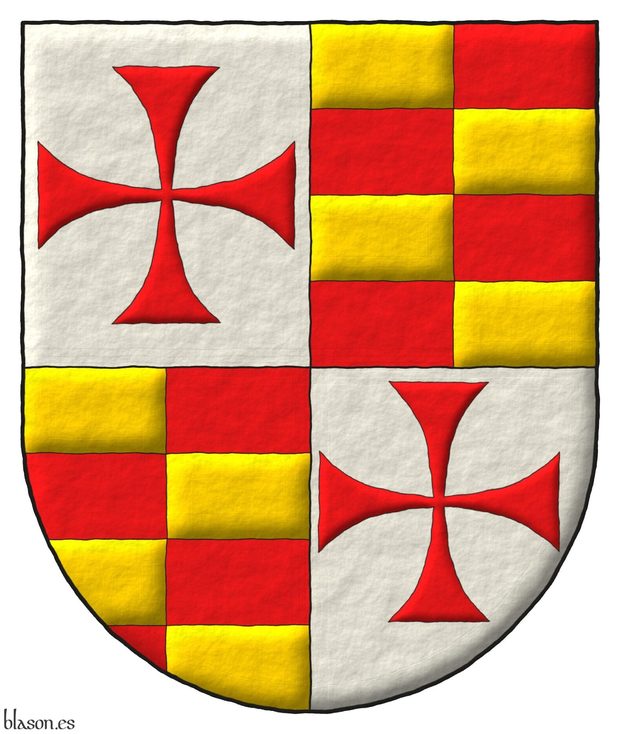
Quarterly: 1 and 4 Argent, a cross patty Gules; 2 and 3 Barry of four per pale counterchanged Or and Gules.
Escudo cuartelado: 1o y 4o de plata, una cruz patada de gules; 2o y 3o de contrafajado de cuatro piezas de oro y gules.
Blazon keywords: Barry per pale counterchanged, Four, Or, Gules, Quarterly, Argent, One, Cross patty and Cross couped.
Style keywords: Outlined in sable, Semi-circular, Illuminated and Freehand.
Classification: Religious, Military, Knights Templar, Interpreted and Coat of arms.
Bearer: Blanchefort, Bertrand de.


Quartered arms of Gilbert Hérail
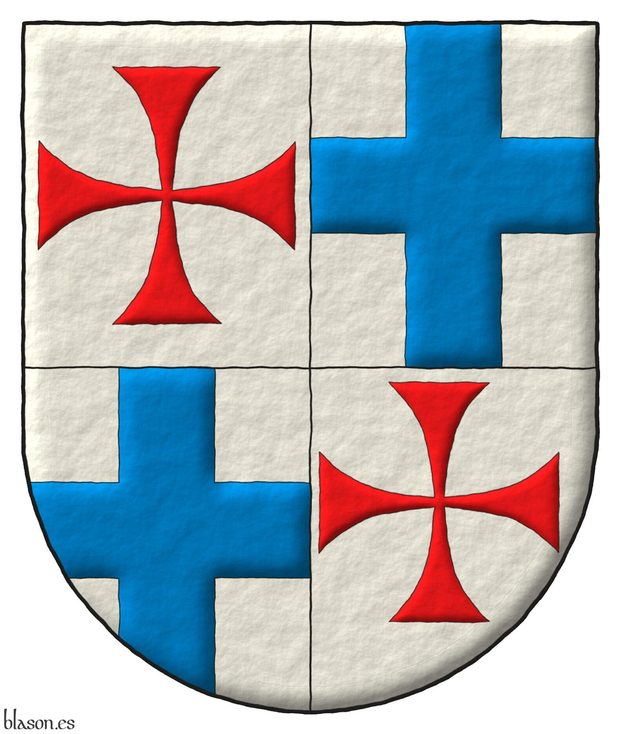
Quarterly: 1 and 4 Argent, a cross patty Gules; 2 and 3 Argent, a cross Azure
Escudo cuartelado: 1o y 4o de plata, una cruz patada de gules; 2o y 3o de plata, una cruz de azur.
Blazon keywords: Argent, One, Cross, Azure, Quarterly, Cross patty, Cross couped and Gules.
Style keywords: Outlined in sable, Illuminated, Semi-circular and Freehand.
Classification: Religious, Military, Knights Templar, Interpreted and Coat of arms.
Bearer: Hérail, Gilbert.


Rada of Navarre
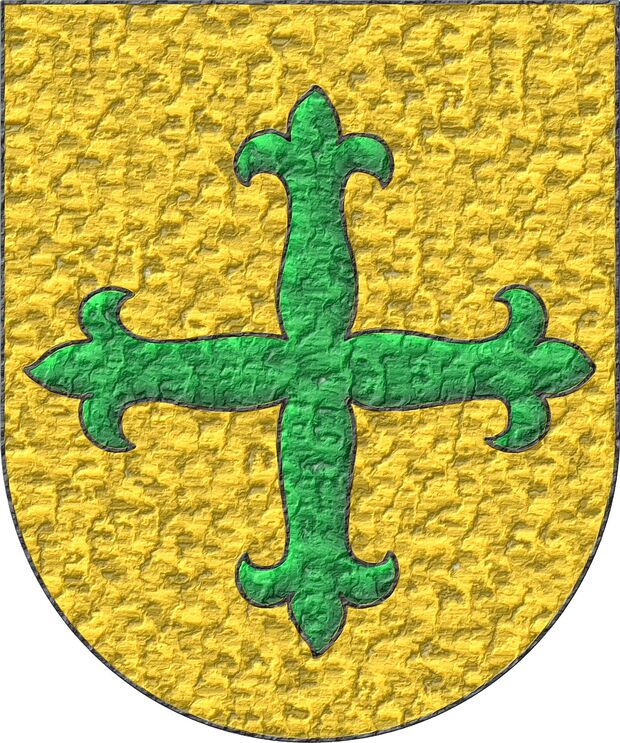
Of the twelve lineages of Noblemen, the eighth is that of Rada; they bear as arms a shield Or with a flory cross Vert, in the same manner as painted in this shield.
Or, a Cross flory Sinople.
Escudo de oro, una cruz flordelisada de sinople.
Coat of arms interpreted with: a semicircular (round) base; the field in flat Or; the flory cross outlined in Sable and illuminated in Vert enamel; and finished in highly-hammered metal.
Based on the eighth coat of arms of the Navarrese «ricoshombres» from [Bosque, J. del; 1540; folio 1 of the numbering of 1613] and the text is from the transcription made by [Martinena Ruiz, J. J.; 1982; pages 122 and 123].
Under the title «Surname of Rada» it can also be consulted in [Vega, P. J. de; 1702; folio 8 of the manuscript].
Blazon keywords: Without divisions, Or, Cross flory, Cross couped and Vert.
Style keywords: Semi-circular, Illuminated, Outlined in sable and Hard metal.
Classification: Interpreted, Personal and Kingdom of Navarre.
Bearer: Rada of Navarre.


Renaud de Vichiers
Vair. Behind the shield an eight-pointed cross patty Gules.
Blazon keywords: Vair, Behind the shield, One, Eight-pointed cross, Cross couped and Gules.
Style keywords: Outlined in sable, Illuminated, Semi-circular and Freehand.
Classification: Religious, Military, Knights Templar, Interpreted and Coat of arms.
Bearer: Vichiers, Renaud de.


Richard de Bures
Or, six annulets Gules, 3, 2, and 1. Behind the shield an eight-pointed cross patty Gules.
The eight-pointed cross patty behind the shield has been diapered with Chinapieria.
Blazon keywords: Or, Six, Annulet, Gules, Ordered, Three, Two, One, Behind the shield, Eight-pointed cross and Cross couped.
Style keywords: Outlined in sable, Semi-circular, Illuminated, Freehand, Diapered and Chinapieria.
Classification: Religious, Military, Knights Templar, Interpreted and Coat of arms.
Bearer: Richard, Richard.


Robert de Craon
Lozengy Or and Gules. Behind the shield a cross patty Gules.
Blazon keywords: Lozengy, Or, Gules, Behind the shield, One, Cross patty and Cross couped.
Style keywords: Outlined in sable, Illuminated, Semi-circular and Freehand.
Classification: Religious, Military, Knights Templar, Interpreted and Coat of arms.
Bearer: Craon, Robert de.


Royal Council of the Orders of Chivalry, emblem
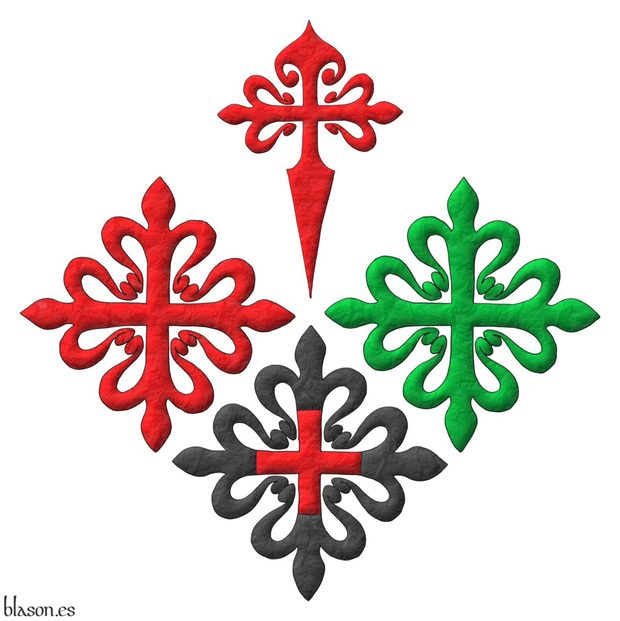
Royal Council of the Orders of Chivalry, of Santiago, Calatrava, Alcantara, and Montesa.
Emblem quarterly per saltire: 1, a cross of Saint James; 2, a cross of Calatrava; 3, a cross of Alcantara; 4, a cross of Montesa.
Emblema cuartelado en sotuer: 1o, una cruz de Santiago; 2o, una cruz de Calatrava; 3o, una cruz de Alcántara; 4o, una cruz de Montesa.
Interpretation of the emblem of the Royal Council with: its four crosses outlined in Sable, illuminated in Gules, Vert, and Sable; and a heavily hammered metal finish.
There is another version of this emblem of the Royal Council with the crosses of its four orders of Santiago, Calatrava, Alcantara, and Montesa outlined in Or instead of Sable.
Blazon keywords: Cross, Quarterly per saltire, Cross of Saint James, Cross couped, Cross of Calatrava, Cross of Alcantara and Cross of Montesa.
Style keywords: Illuminated, Outlined in sable and Freehand.
Classification: Interpreted, Socioeconomic and Emblem.
Bearer: Royal Council of the Orders of Chivalry.


Sean Shriner, Knight of Magistral Grace of the Order of Malta
Argent, flanched Gules crusilly of cross-crosslets Argent, overall a bear rampant regardant Sable, armed and langued Azure, charged with a key and a sword in saltire Argent, hilted Or, the key debruised by the sword. Crest: Upon a helm with a wreath Argent and Gules, issuant from a bridge, enarched, embattled Gules, masoned Sable above a river Azure, a bear’s forepaw Sable, armed Azure, grasping a cross crosslet fitchy bendwise sinister Gules. Mantling: Gules doubled Argent. Motto: «Fide Gratia Obedientia» Gules over a scroll Argent. Suspended from the shield the cross of Knight of Magistral Grace of the Sovereign Military Order of Malta.
Coat of arms depicted by me, illuminated with lights and shadows, outlined in Sable, with a pointed outer contour and with a leather finish.
Blazon keywords: Argent, Gules, Sable, Azure, Or, One, Flanched, Semé, Cross-crosslet, Cross couped, Overall, Bear, Rampant, Regardant, Armed, Langued, Charged, Key, Sword, In saltire, Hilted, Debruised, Crest, Upon (wreath), Helm, Wreath, Issuant, Enarched, Bridge, Embattled, Masoned, Above, River, Forepaw, Grasping, Cross fitchy, Bend sinisterwise, Mantling, Doubled, Motto, Scroll, Suspended from the shield and Decoration.
Style keywords: Outlined in sable, Illuminated, Pointed and Leather.
Classification: Personal, Interpreted, Boa and Coat of arms.
Bearer: Shriner, Sean.


Sister Esperanza Vega Lanzagorta, plain tincture
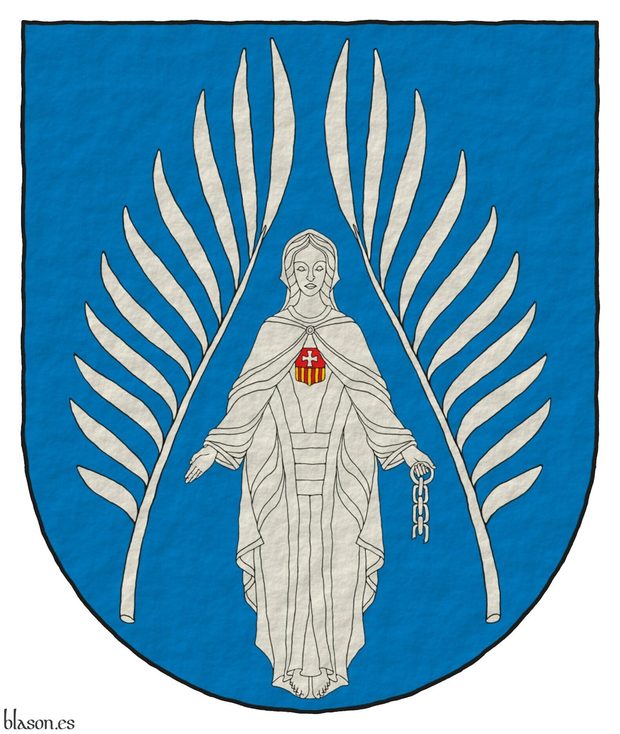
Azure, between two palm fronds in pile reversed a Lady of Mercy grasping in her sinister hand a broken chain Argent, and charged on the chest with an escutcheon per fess, 1 Gules, a cross patty Argent, and 2 Or, four pallets Gules.
Coat of arms designed by me, in flat tinctures, outlined in Sable, with a semi-circular external shape and with a texturized finishing.
This is the coat of arms of Sister Esperanza Vega Lanzagorta, designed by Juan Lanzagorta Vallin and painted by me. Alternative blazon: «Azure, between two palm fronds in pile reversed a Virgin of Mercy grasping in her sinister hand a broken chain Argent, and charged on the chest the Mercedarian coat of arms».
Credits: Juan Lanzagorta Vallin is the designer of the coat of arms.
Blazon keywords: Azure, Argent, Gules, Or, One, Two, Our Lady of Mercy, Grasping, Sinister, Hand, Broken, Chain, Charged, Chest, Escutcheon, Party per fess, Cross patty, Cross couped, Between, Palm frond and In pile reversed.
Style keywords: Outlined in sable, Plain tincture and Semi-circular.
Classification: Personal, Created, Boa and Coat of arms.
Bearer: Vega Lanzagorta, Sister Esperanza.


Standard of Austin Charles Berry
Structure of this standard:
- His coat of arms.
- His crest.
- The 1st line of his motto «Silentium est».
- His badge.
- The 2nd line of the motto «Aureum».
- His crest.
Blazon keywords: Vert, One, Chevron, Between, Three, Cross-crosslet, Cross couped, Chief, Argent, Griffin, Statant, Gules, Beaked, Armed, Or, Cyclamor, Motto, Two, Wreath, Head and Party per fess.
Classification: Personal, Interpreted, Standard and Flag.
Bearer: Berry, Austin Charles.


![Ver [Templar and Humanitarian Order of the Kingdom of Spain in Twelve Lineages] en enlaces recomendados. Áncora de oro y la divisa enlace.](../css/Ancora.Enlace.png)
Templar and Humanitarian Order of the Kingdom of Spain in Twelve Lineages
My interpretation of the arms of the Templar and Humanitarian Order of the Kingdom of Spain with the help of Antonio José Gómez Morillo, on the blog Twelve Lineages of Soria in an article entitled: Beautiful rendering of the Arms of the T.H.O.K.S., created by Mr. Antonio Salmerón Cabañas.
Categories: Link, Watercolor, Freehand, Semi-circular, Closed royal crown, Crown, Supporter (human form), Supporter, Mantle, Sable, Gules, Argent, Or, Ermine, Cross of Saint James, Cross couped, Escallop, Flag and Party per pale.
Root: Twelve Lineages of Soria.


Tercio Alessandro Farnese, plain tincture
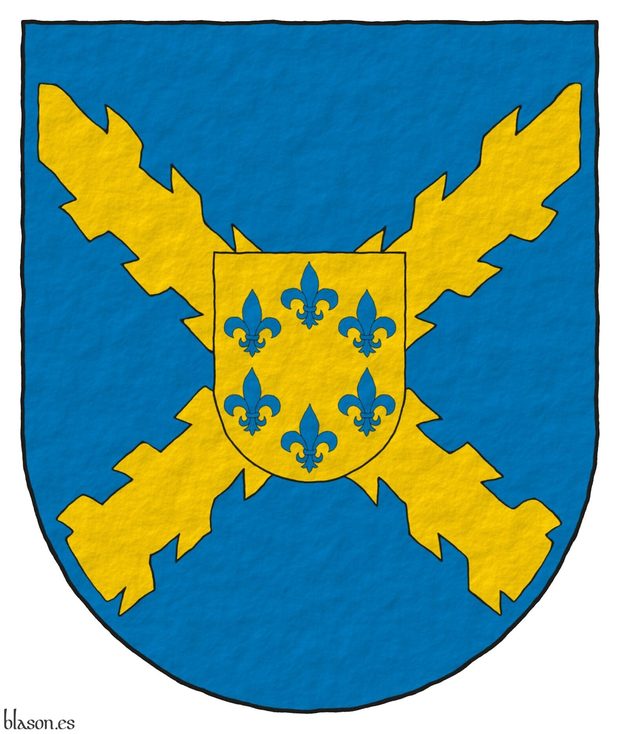
Azure, a cross of Burgundy Or; an inescutcheon Or, six fleurs de lis in orle Azure.
Coat of arms depicted by me, in plain tinctures, outlined in Sable, with a semi-circular external shape and with a texturized finishing.
Coat of arms of the Tercio Alessandro Farnese, 4th of the Spanish Legion, emblazoned by me. In 1956, the fourth Tercio of the Spanish Legion was created and named Tercio Alessandro Farnese in his honor. The inescutcheon has in orle the 6 fleurs the lis of the Farnese family.
Blazon keywords: Azure, Or, One, Six, Cross of Burgundy, Cross couped, Inescutcheon, Fleur de lis and In orle.
Style keywords: Outlined in sable, Plain tincture and Semi-circular.
Classification: Military, Interpreted, Boa and Coat of arms.
Bearer: Tercio Alessandro Farnese.


Tercio Great Captain, plain tincture
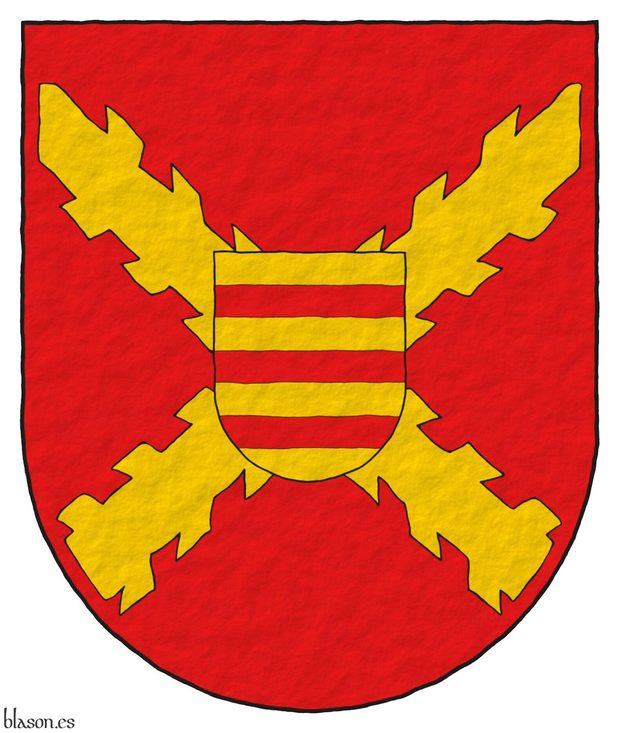
Gules, a cross of Burgundy Or; an inescutcheon Or, three bars Gules.
Arms interpreted by me, in plain tinctures, outlined in Sable, with a semi-circular outer contour and with a texturized finish.
Coat of arms of the Tercio Great Captain, 1st of the Spanish Legion, emblazoned by me. The inescutcheon represents the coat of arms of Gonzalo Fernandez de Cordoba, 1453-1515, known as «The Great Captain». It was Gonzalo Fernandez de Cordoba who reorganized the Spanish infantry, laying the foundations for what would later become the Tercios.
Blazon keywords: Gules, Or, One, Three, Cross of Burgundy, Cross couped, Inescutcheon, Bar and Fess.
Style keywords: Outlined in sable, Plain tincture and Semi-circular.
Classification: Military, Interpreted, Boa and Coat of arms.
Bearer: Tercio Great Captain.


My heraldic channel at WhatsApp is whatsapp.com/channel/0029VbAV5sk3LdQbvWgP4p43 or blason.es/whatsapp.
Categories: Technology, Social networks, Lion, Rampant, Armed, Langued, Label, Behind the shield, Eight-pointed cross and Cross couped.
-
Language
-
Categories of heraldry
-
Divisions of the field
- Without divisions
- Party per pale
- Party per fess
- Party per bend
- Party per bend sinister
- Tierce
- Tierce sinister
- Tierced per pale
- Tierced per fess
- Tierced per bend
- Tierced pallwise inverted
- Quarterly
- Quarterly per saltire
- Gyronny
- Party per fess, the chief per pale
- Party per pale, the sinister per fess
- Party per fess, the base per pale
- Party per pale, the dexter per fess
- Chapé
- Chaussé
- Embrassé
- Contre-embrassé
- Party per chevron
- Enté
- Enté en point
- Flanched
-
Metals
-
Colours
-
Furs
-
Other tinctures
-
Ordinaries and sub-ordinaries
-
Diminutives of the ordinaries
-
Geometric charges
-
Composite ordinaries
-
Inanimate charges from Nature
Atom, Crescent, Diamond, Emerald, Estoile, Increscent, Lightning flash, Moon, Mount, Mullet, Mullet of four points, Orbital, Plough of Ursa Major, Rainbow, Ray of the sun, River, Sea, Snowflake, Sun, Sun in splendour, Sun of May, Trimount, Water and Wave.
-
Vegetal charges from Nature
Acorn, Apple, Apple tree, Ash, Bluebonnet, Camellia, Chrysanthemum, Cinquefoil, Cornflower, Dogwood flower, Double rose, Elm, Fleur de lis, Flower, Gourd, Holm oak, Hop cone, Kapok tree, Laurel, Lily, Linden, Lotus flower, Madonna lily, Mexican cedar tree, Oak, Olive tree, Palm tree, Plantain plant, Pomegranate, Poplar leaf, Rose, Shamrock, Sunflower, Thistle, Tree, Tulip, Vine and Wheat.
-
Animal charges from Nature
Badger, Bald eagle, Barbel, Barn owl, Bear, Beaver, Beetle, Bighorn sheep, Blackbird, Boar, Brach hound, Bull, Doe, Dog, Dolphin, Dove, Eagle, Elephant, Falcon, Female figure, Fish, Flame, Fly, Fox, Frog, Goat, Goldfinch, Goose, Heron, Horse, Hummingbird, Jaguar, Lark, Leopard, Lion, Lion passant, Lion rampant guardant, Lioness, Lynx, Male figure, Martlet, Merino ram, Owl, Panther, Parrot, Peacock, Pelican, Pelican in her piety, Puffin, Quetzal, Raven, Roe deer, Rooster, Savage, Seagull, Serpent, She-wolf, Stag, Starling, Talbot, Tyger, Vulture, Warren hound and Wolf.
-
Parts of natural charges
Arm, Beak, Branch, Caboshed, Chest, Claw, Covert, Dorsal fin, Eagle claw, Ermine spot, Escallop, Feather, Foot (palmiped), Foreleg, Forepaw, Hand, Head, Heart, Hoof, Leaf, Neck, Ostrich feather, Palm frond, Paw, Roe deers' attires, Shoulder, Sprig, Stags' attires, Stem, Swallow-tail, Tail, Tail addorsed, Tail fin, Talon, Tibia, Tooth, Trunk, Trunk (elephant), Two hands clasped, Two wings in vol, Udder, Wheat spike, Wing and Wrist.
-
Artificial charges
Ace of spades, Anchor, Anvil, Arch, Arm vambraced, Armillary sphere, Arrow, Axe, Bell, Bell tower, Beret, Bonfire, Book, Bookmark, Bow, Branding iron, Bridge, Broken, Buckle, Cannon, Cannon dismounted, Cannon port, Canopy roof, Carbuncle, Castle, Celtic Trinity knot, Chain, Chess rooks, Church, Clarion, Clay pot, Closed book, Club, Column, Comb, Compass rose, Conductor's baton, Cord, Covered cup, Crozier, Crucible, Cuffed, Cup, Cyclamor, Dagger, Double vajra, Drum, Ecclesiastical cap, Fanon, Federschwert, Fleam, Four crescents joined millsailwise, Galician granary, Garb, Gauntlet, Geometric solid, Grenade, Halberd, Hammer, Harp, Host, Hourglass, Key, Key ward, Knight, Knot, Lantern, Letter, Line, Loincloth, Menorah, Millrind, Millstone, Millwheel, Monstrance, Mortar, Mullet of six points pierced, Nail, Non-classic artifact, Norman ship, Number, Oar, Oil lamp, Open book, Page, Pair of scales, Parchment, Pestle, Piano, Pilgrim's staff, Plough share, Polish winged hussar, Port, Portcullis, Potent, Quill, Ribbon, Rosette of acanthus leaves, Sabre, Sackbut, Sail, Scroll, Scythe, Sheaf of tobacco, Ship, Skirt, Spear, Spear's head, Stairway, Star of David, Step, Sword, Symbol, Tetrahedron, Torch, Tower, Trident, Trumpet, Turret, Two-handed sword, Wagon-wheel, Water-bouget, Wheel, Winnowing fan and With a turret.
-
Immaterial charges
Angel, Archangel, Basilisk, Dragon, Dragon's head, Garuda, Golden fleece, Griffin, Heart enflamed, Justice, Mermaid, Our Lady of Mercy, Ouroboros, Paschal lamb, Pegasus, Phoenix, Sacred Heart of Jesus, Saint George, Sea-griffin, Trinity, Triton, Unicorn, Winged hand and Wyvern.
-
External elements
-
Heraldic creations
-
References
-
Formats
-
Keywords on this page
Behind the shield, Between, Watercolor, Pointed, Armed, Azure, Flag, Boa, Wreath, Charged, Crest, Ogee, Crown, Party per fess, Cross, Eight-pointed cross, Cross flory, Cross patty, Cross potent, Cross couped, Quarterly, Four, Outlined in sable, Two, Emblem, In base, Coat of arms, Scroll, Personal, Gules, Illuminated, Interpreted, Chief, Langued, Motto, Lion, Semi-circular, Military, Knights Templar, Or, Argent, Without divisions, Rampant, Religious, Sable, Vert, Freehand, Three and One.


